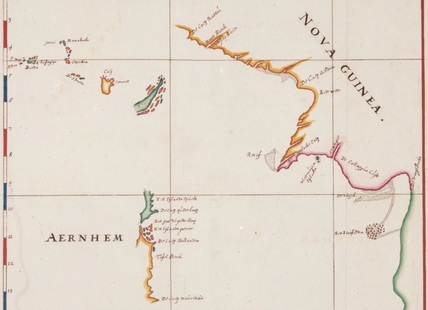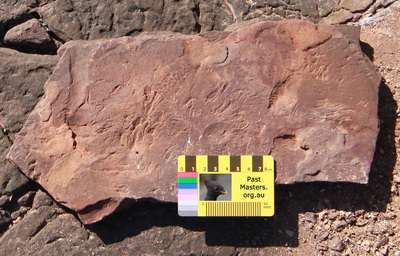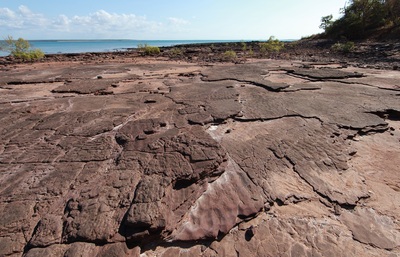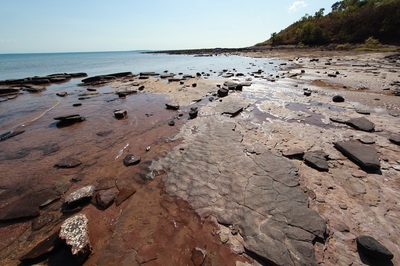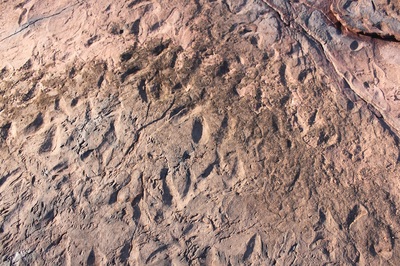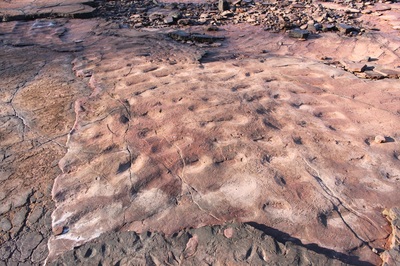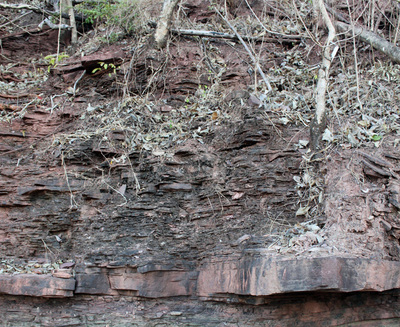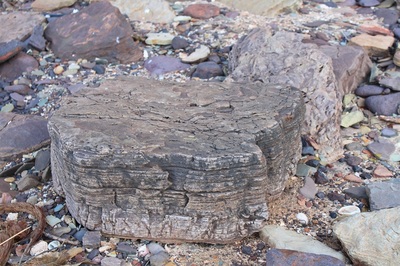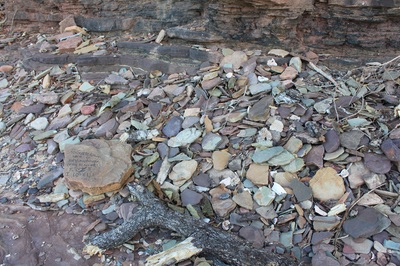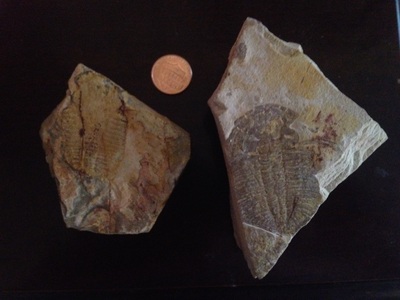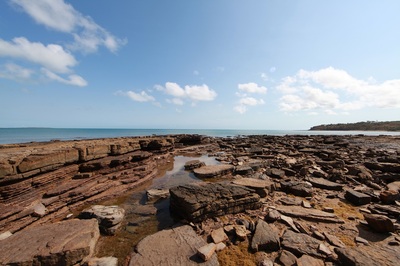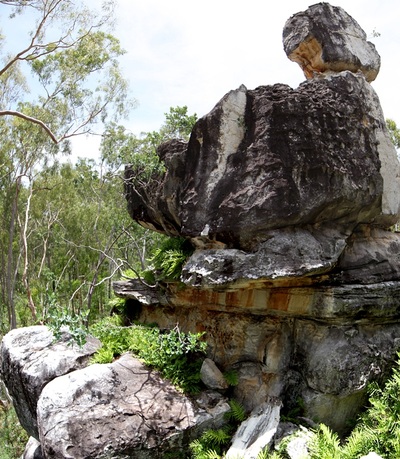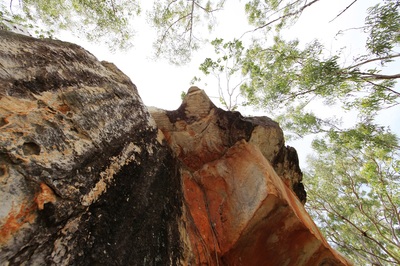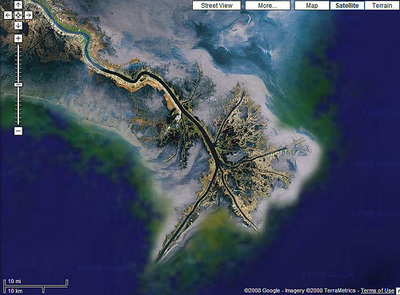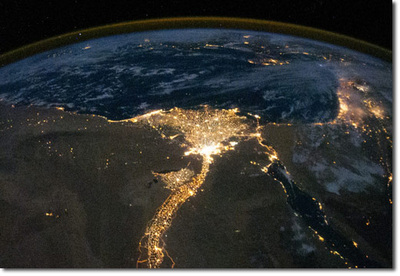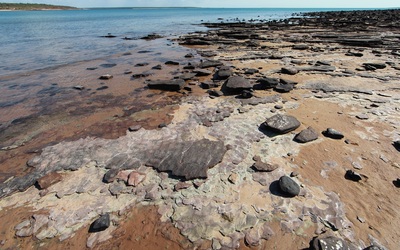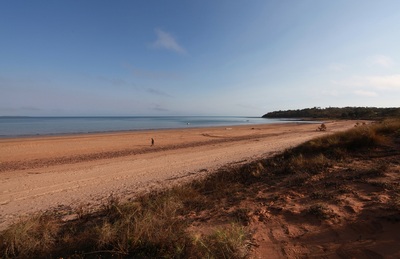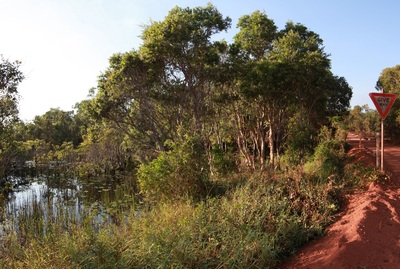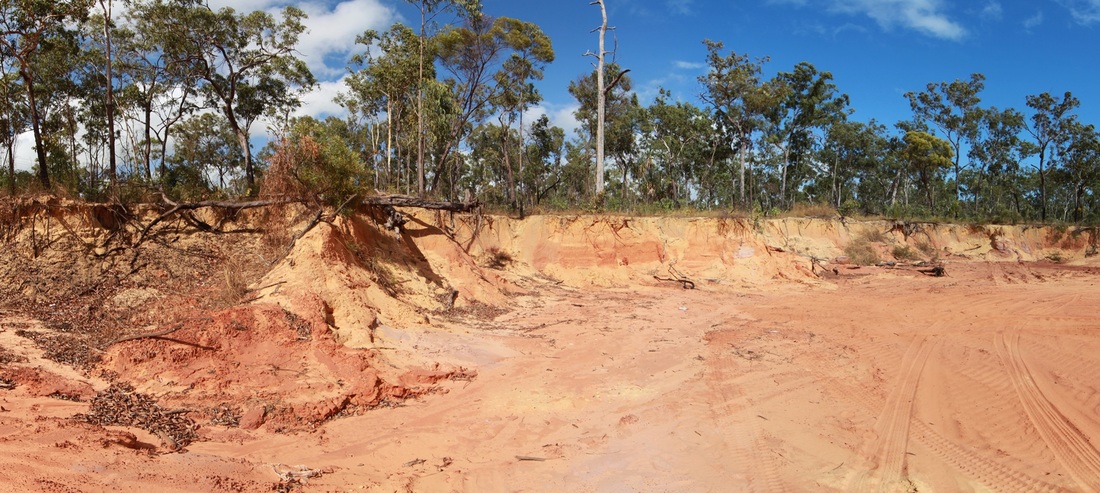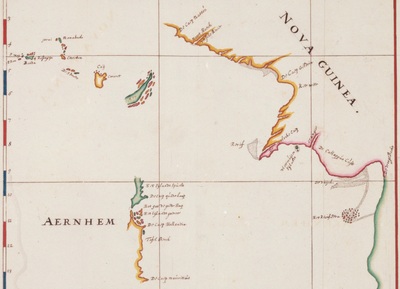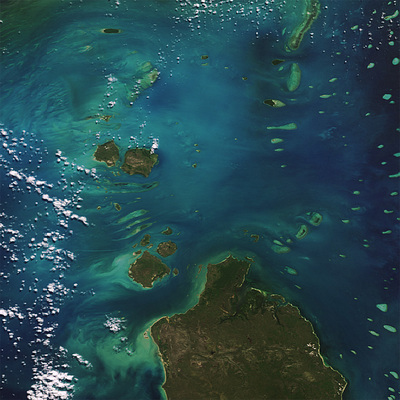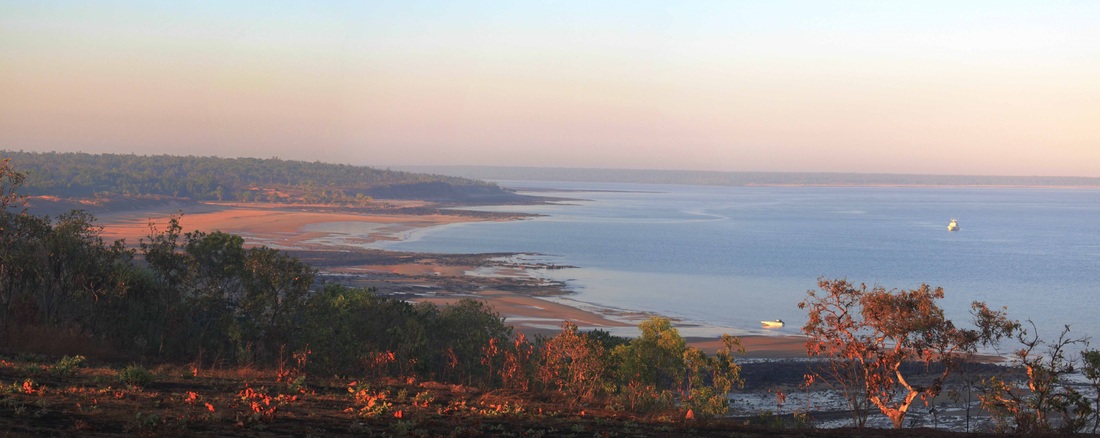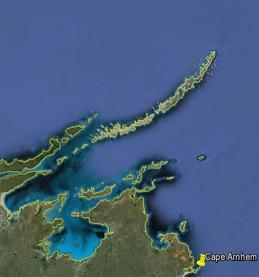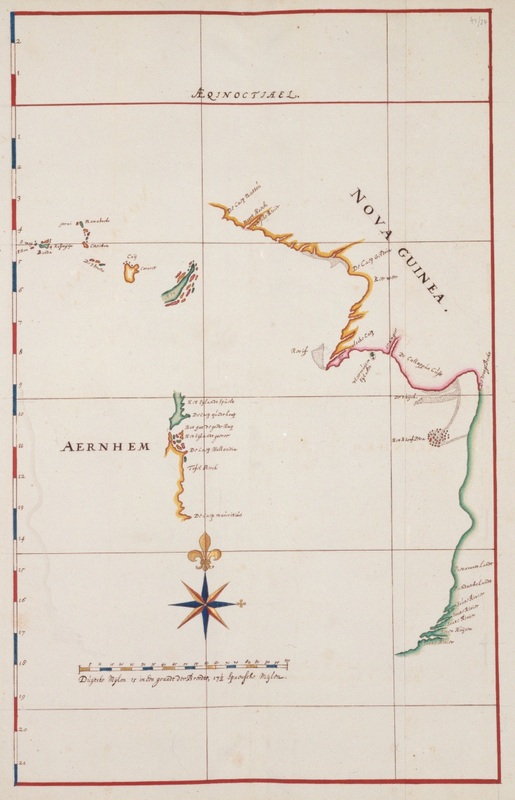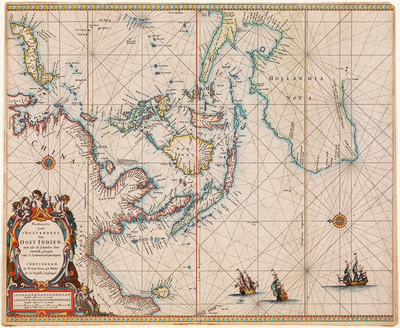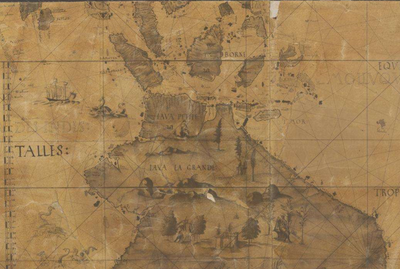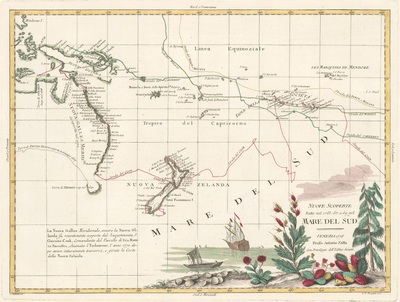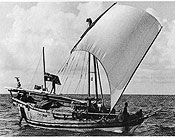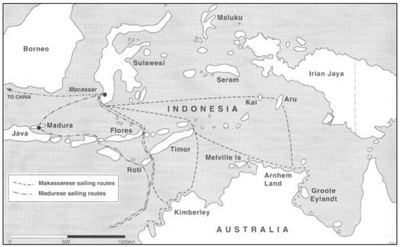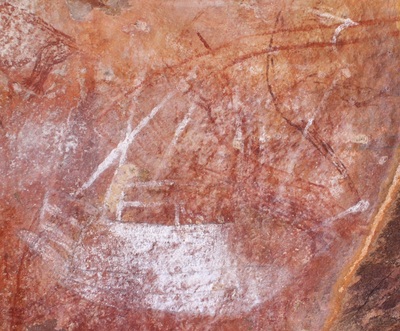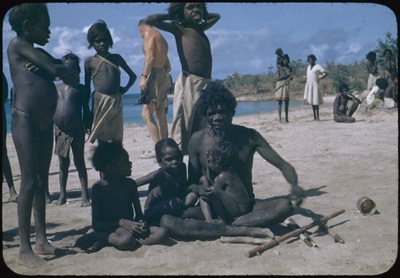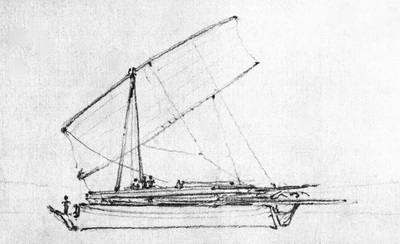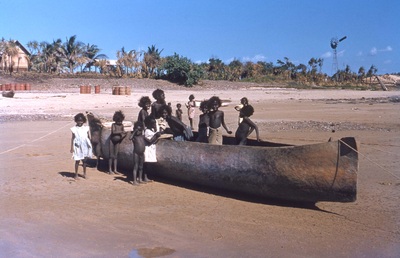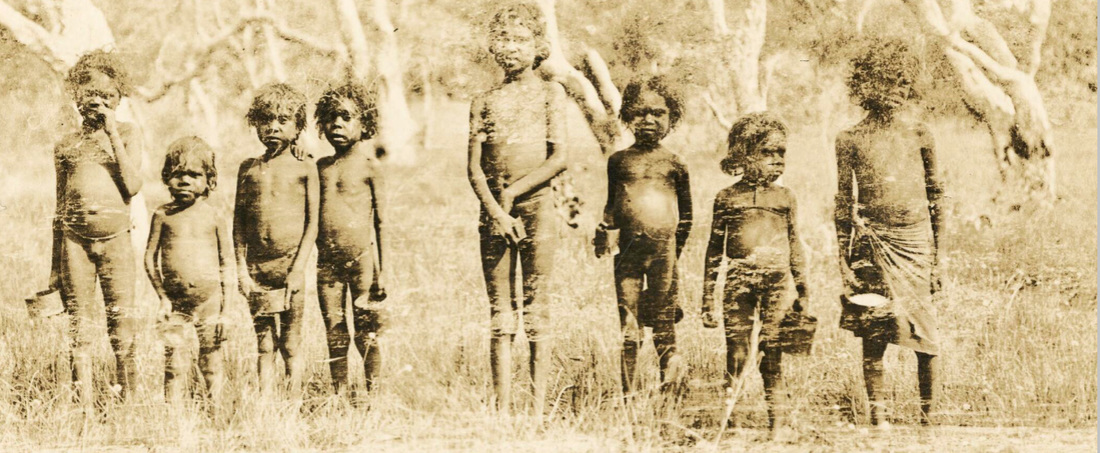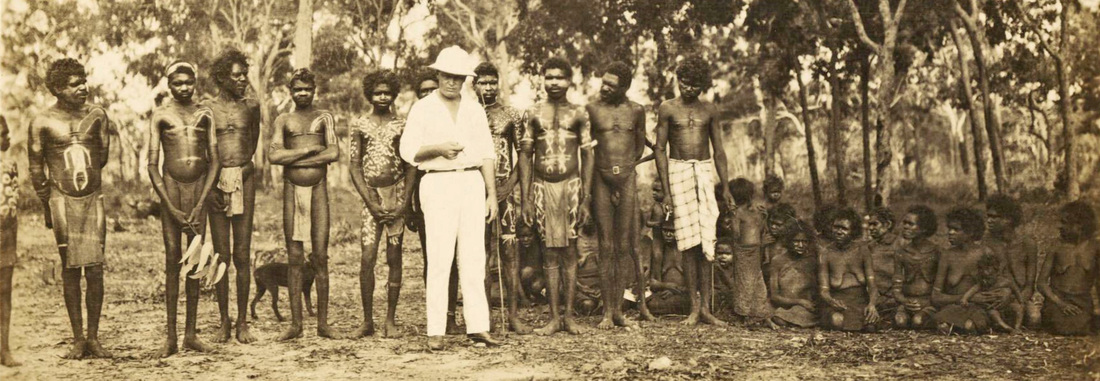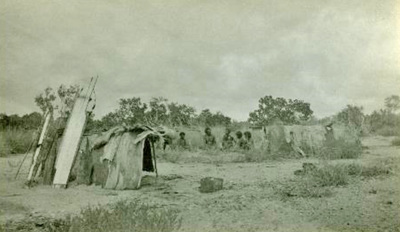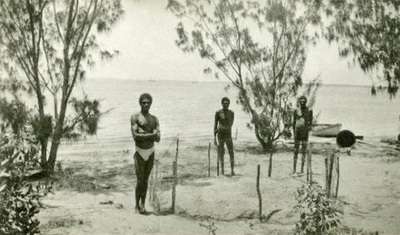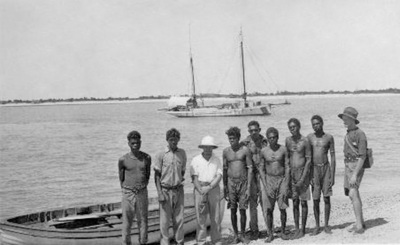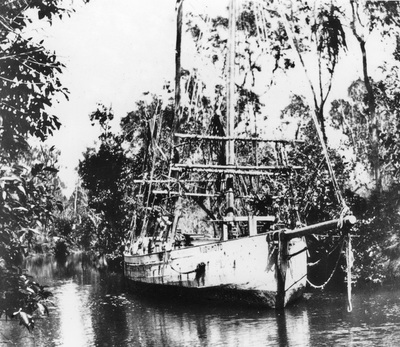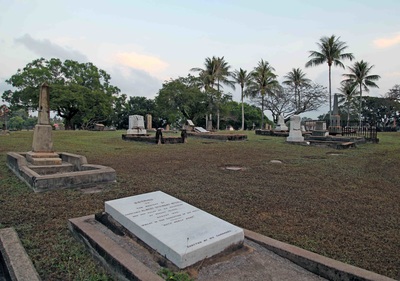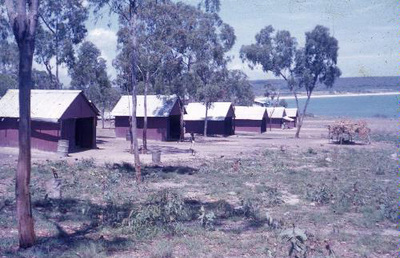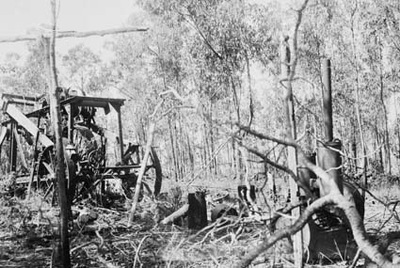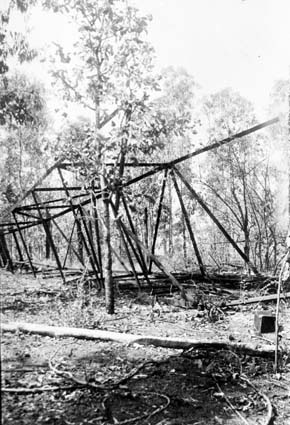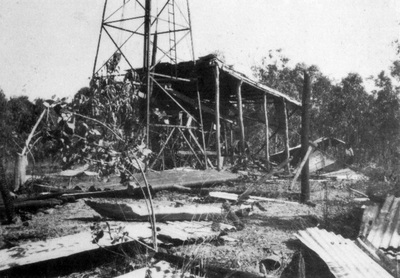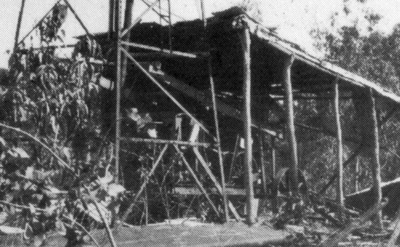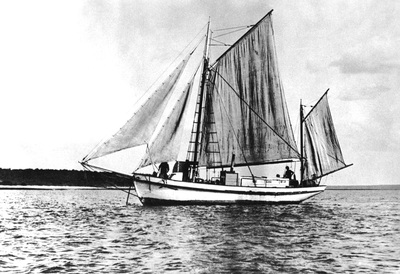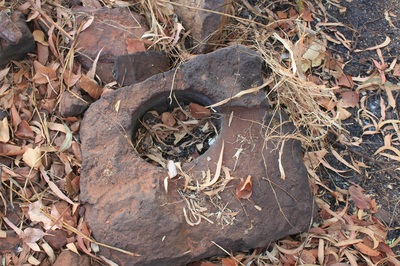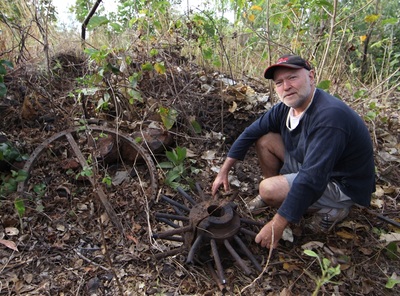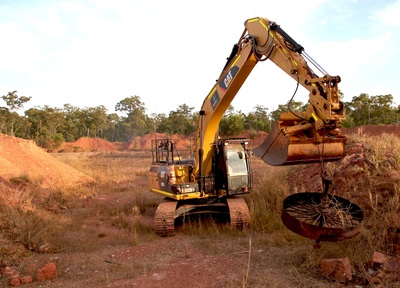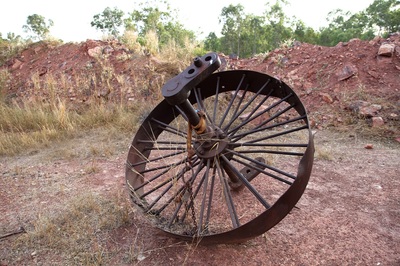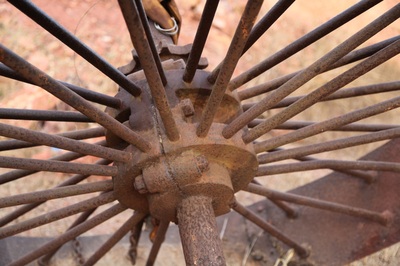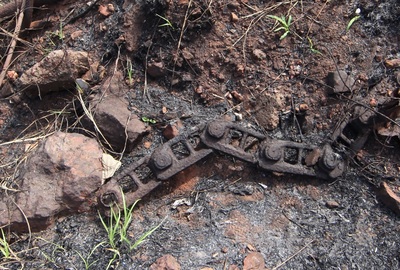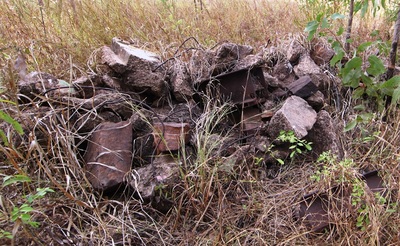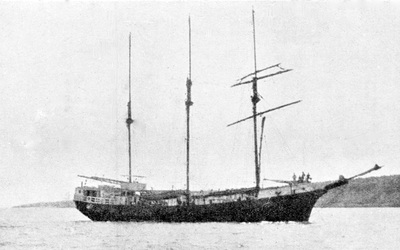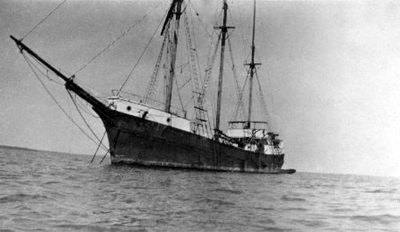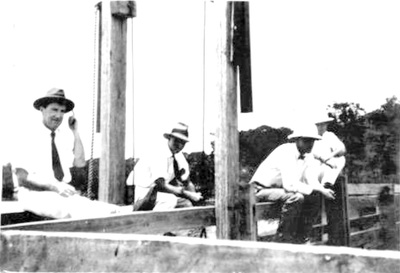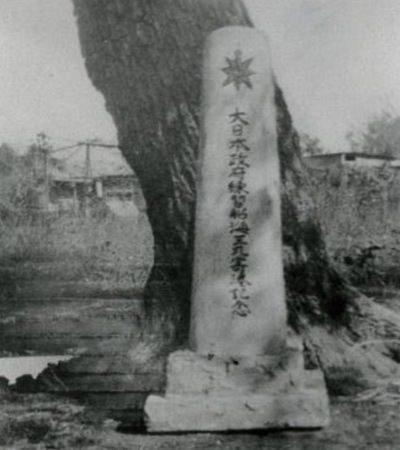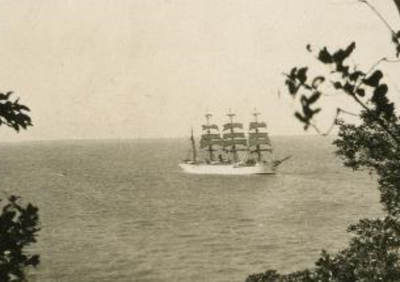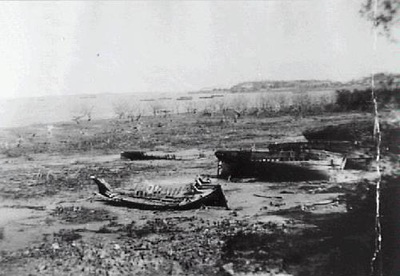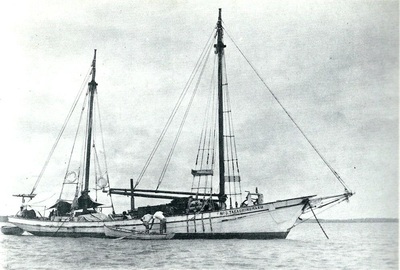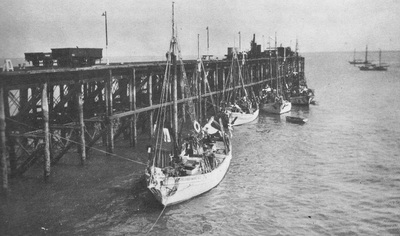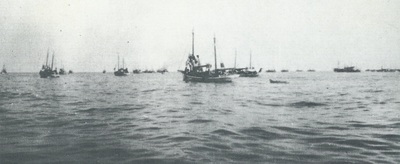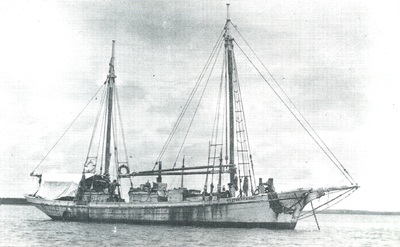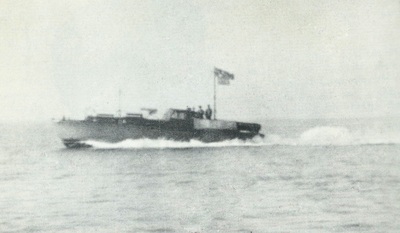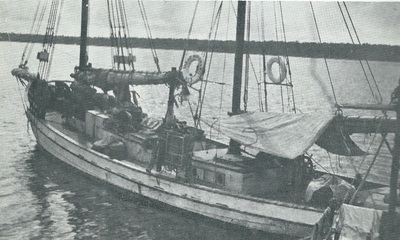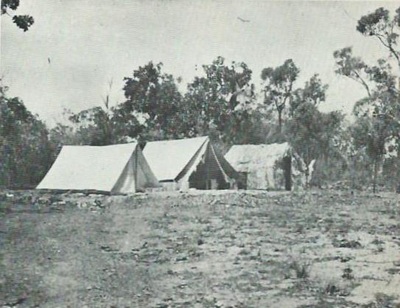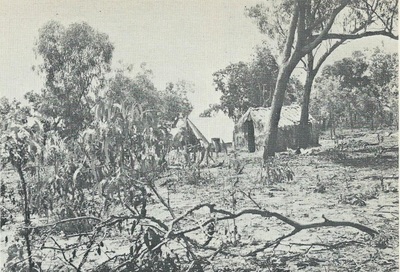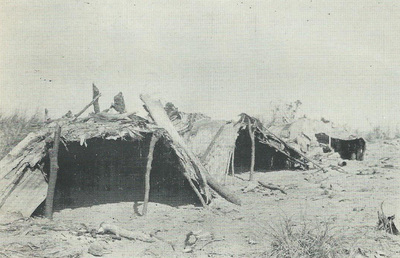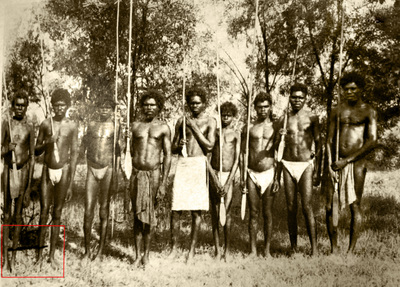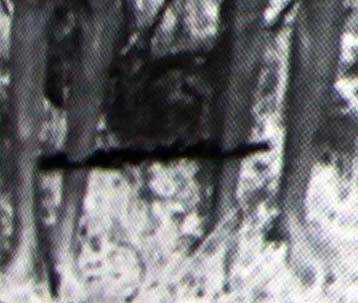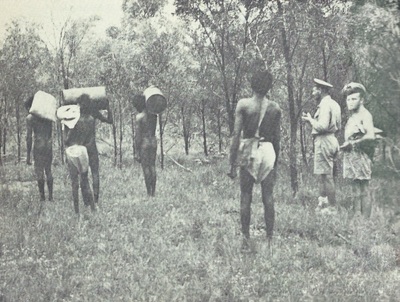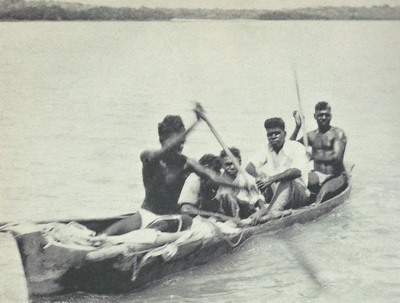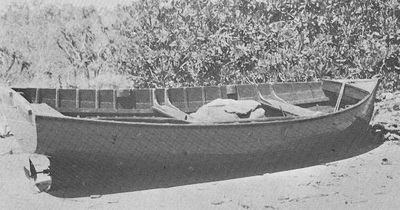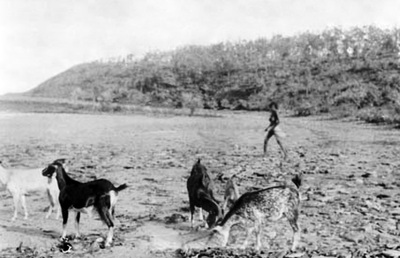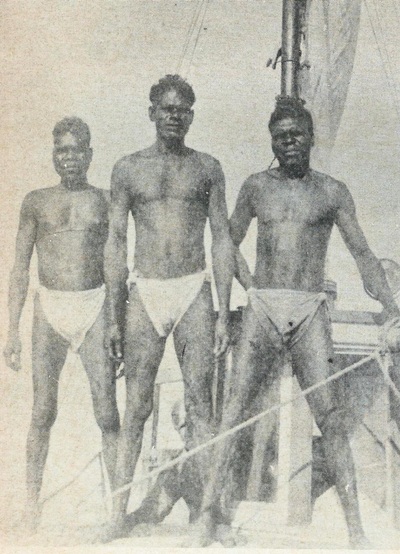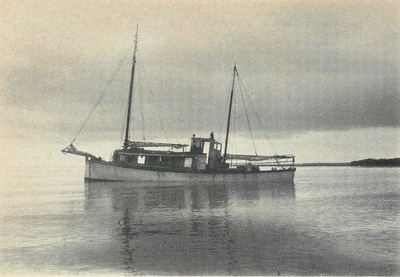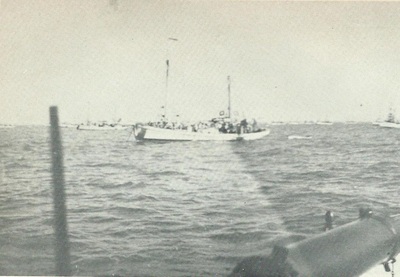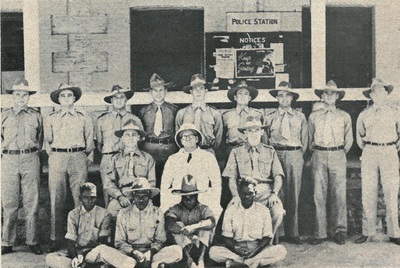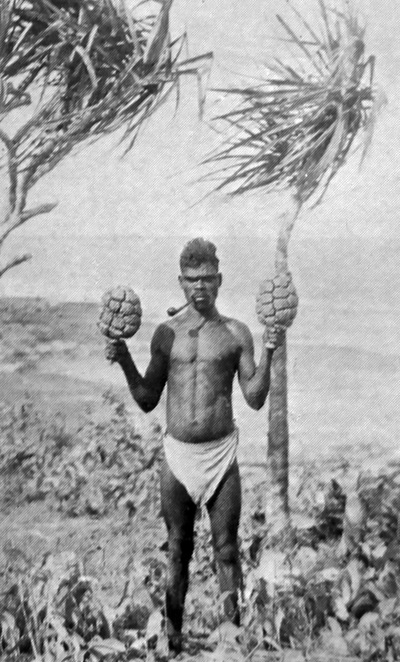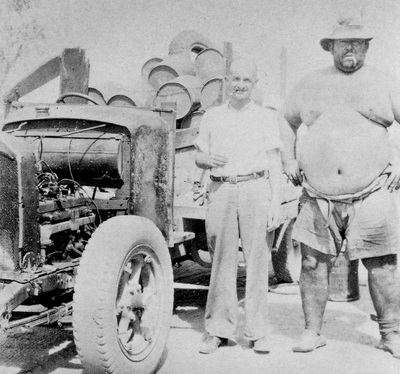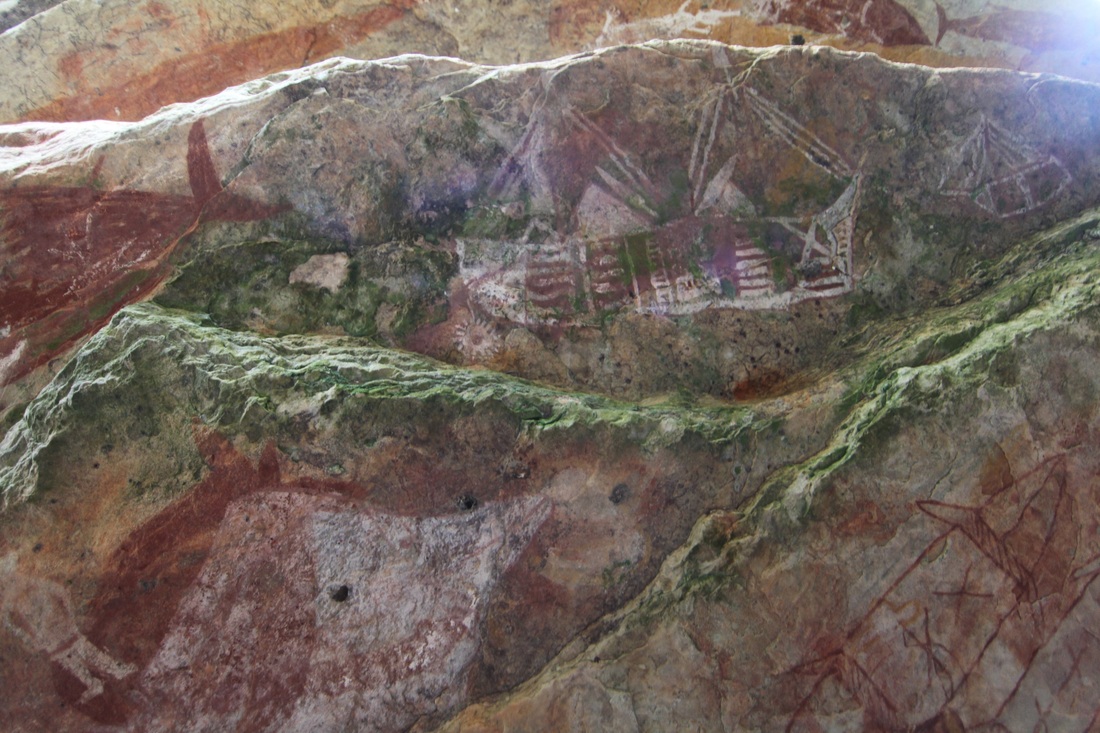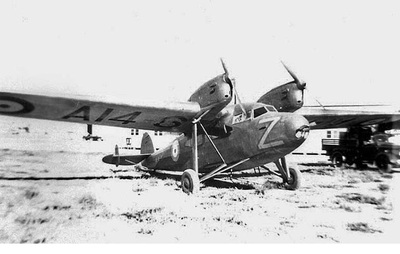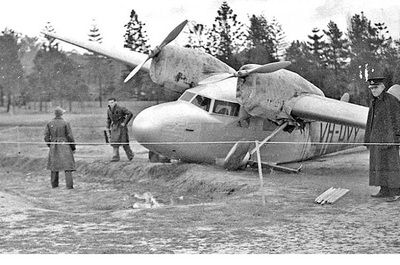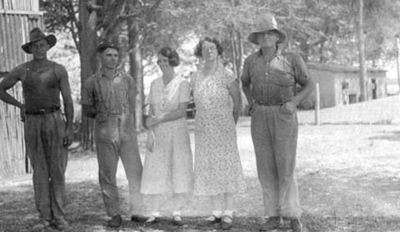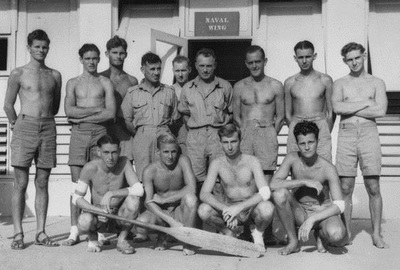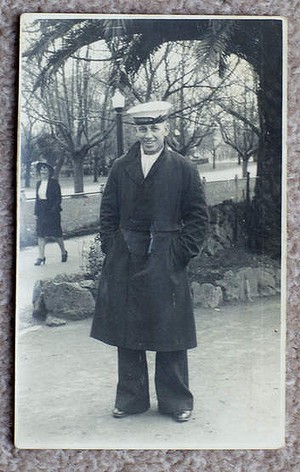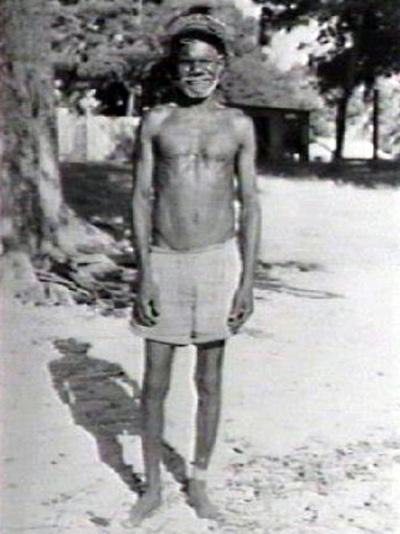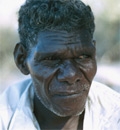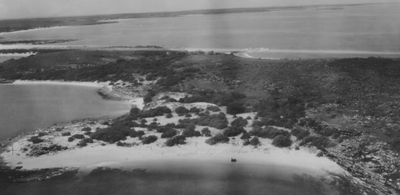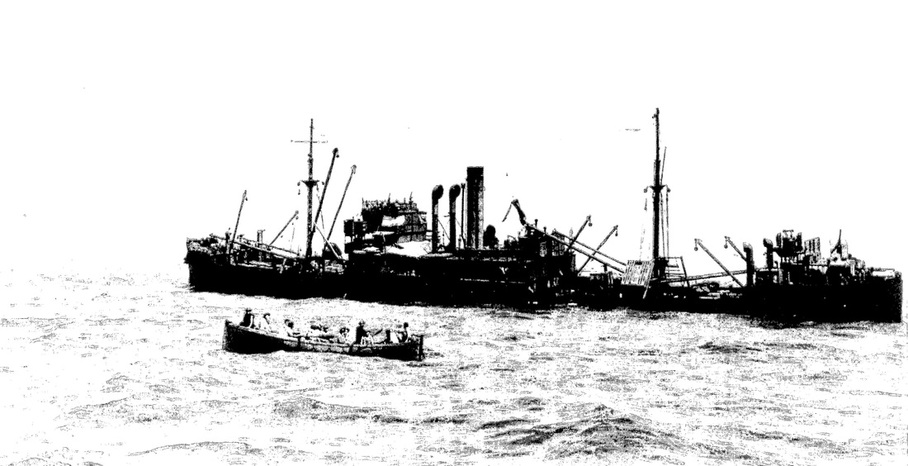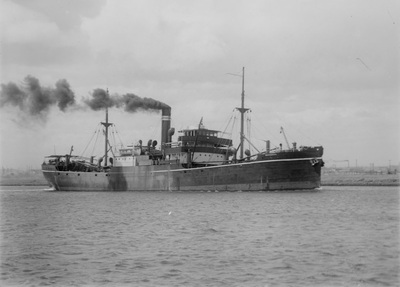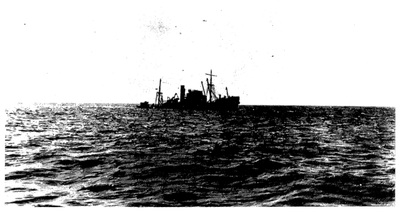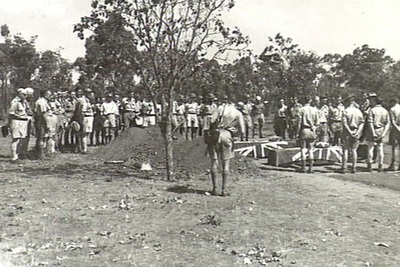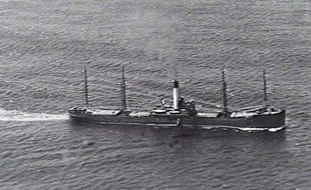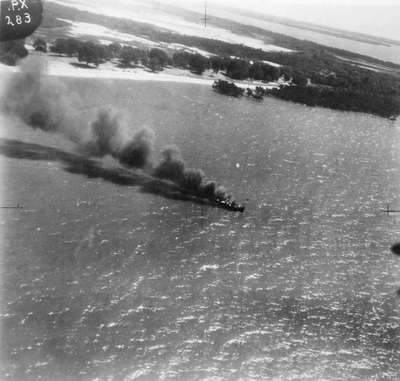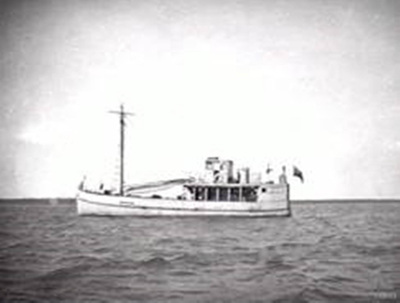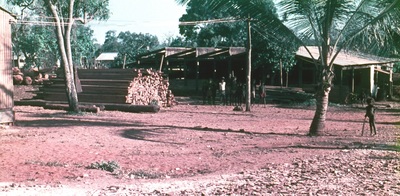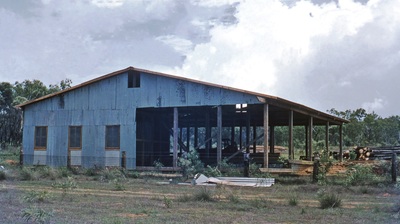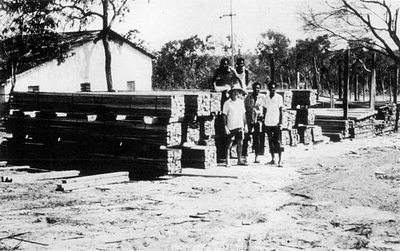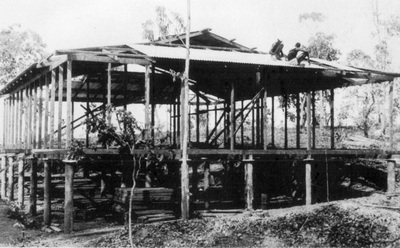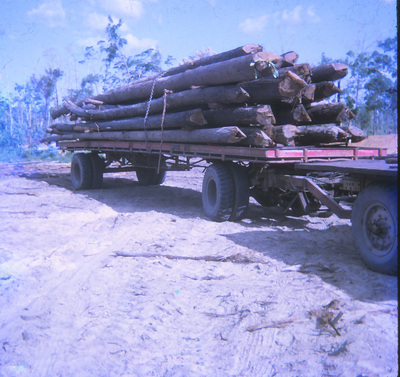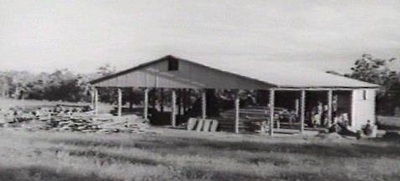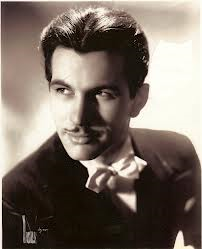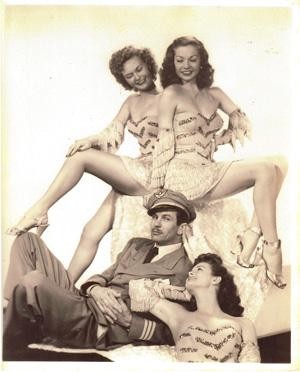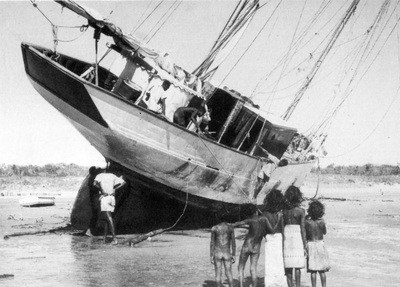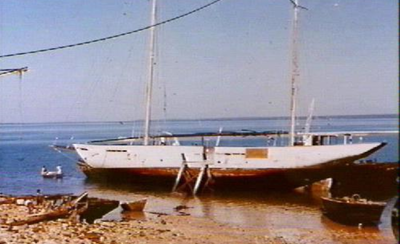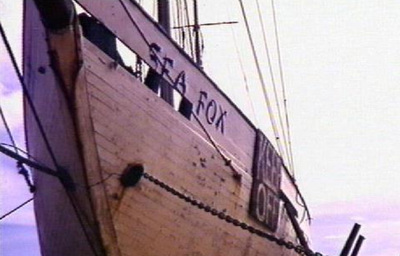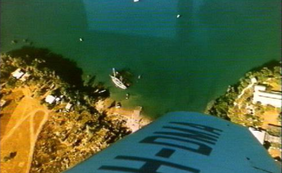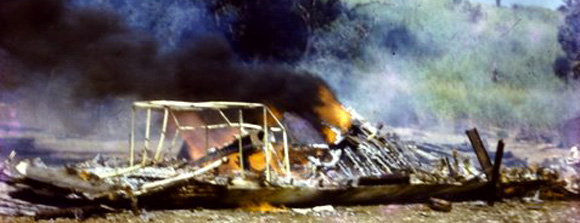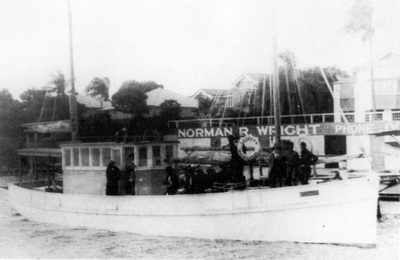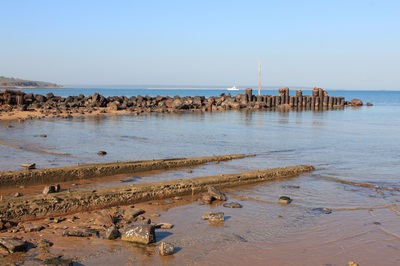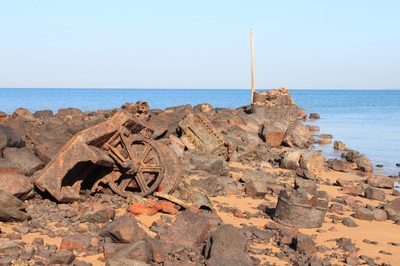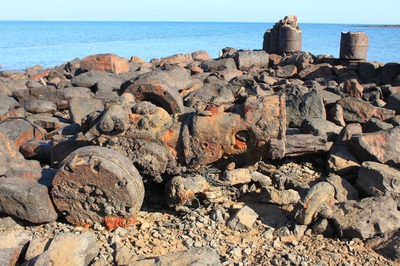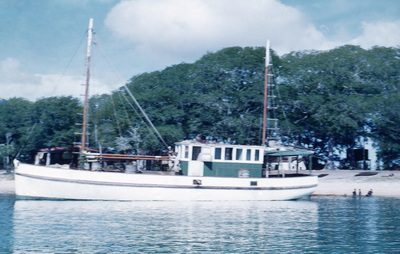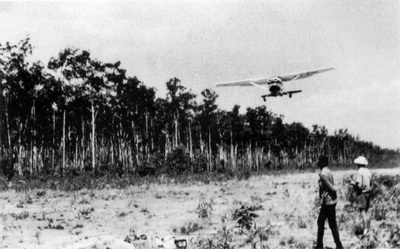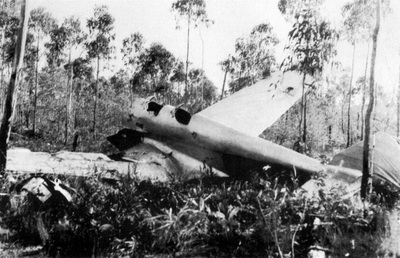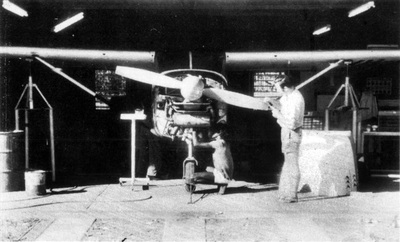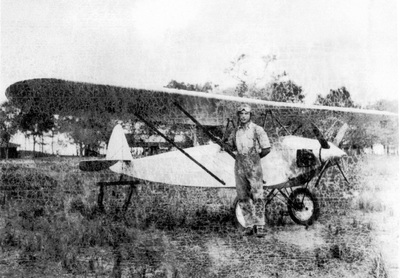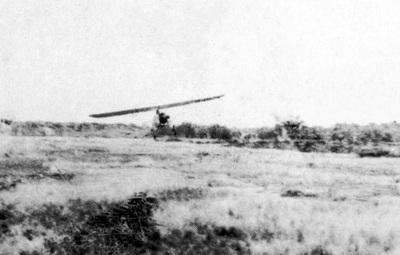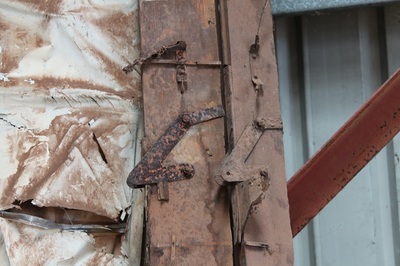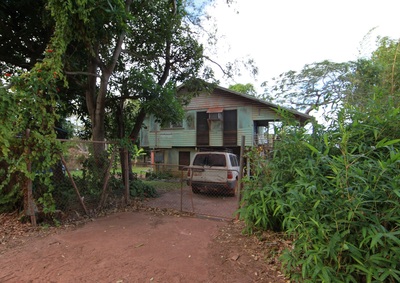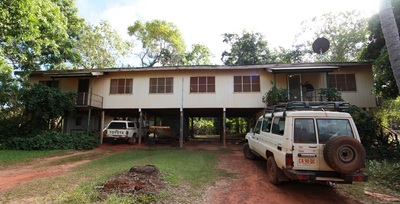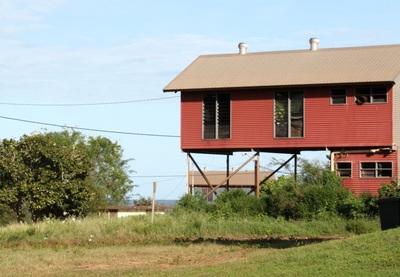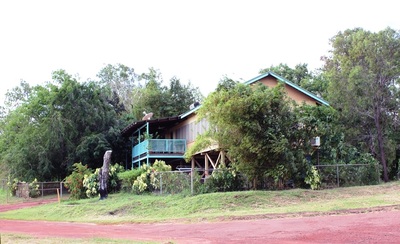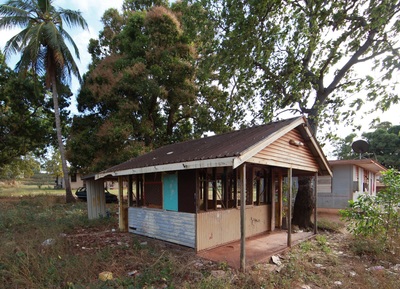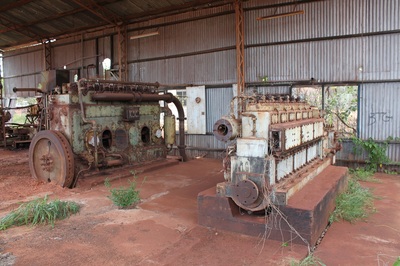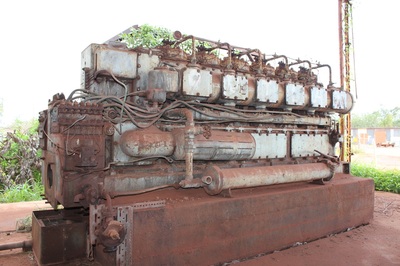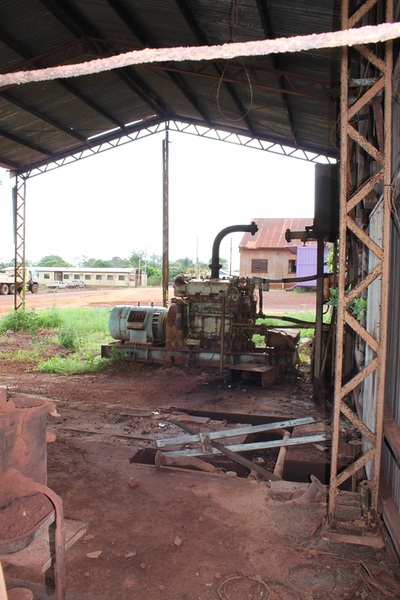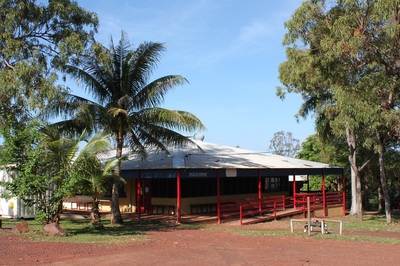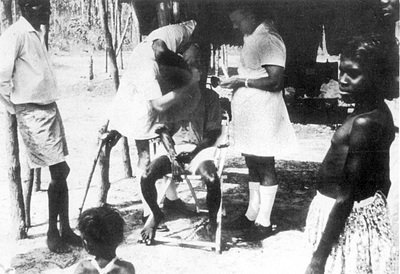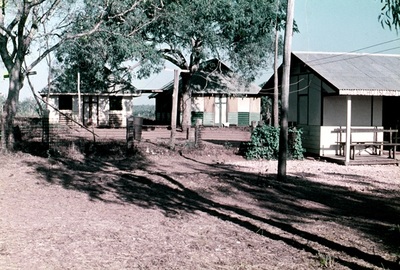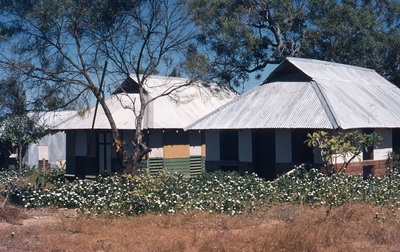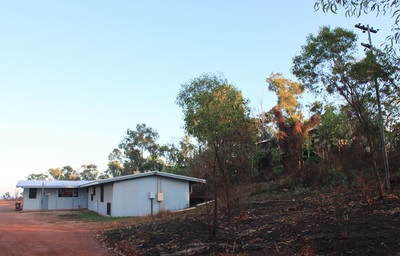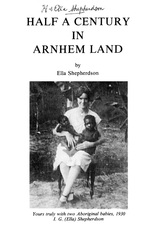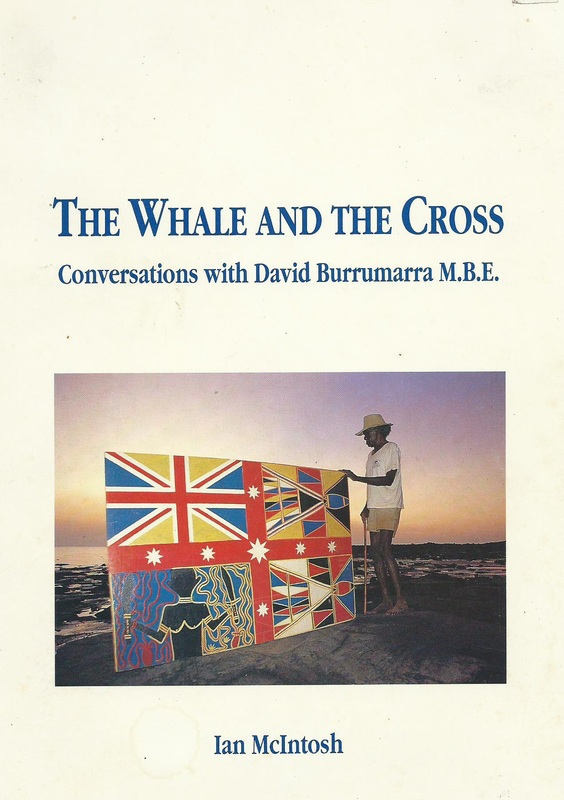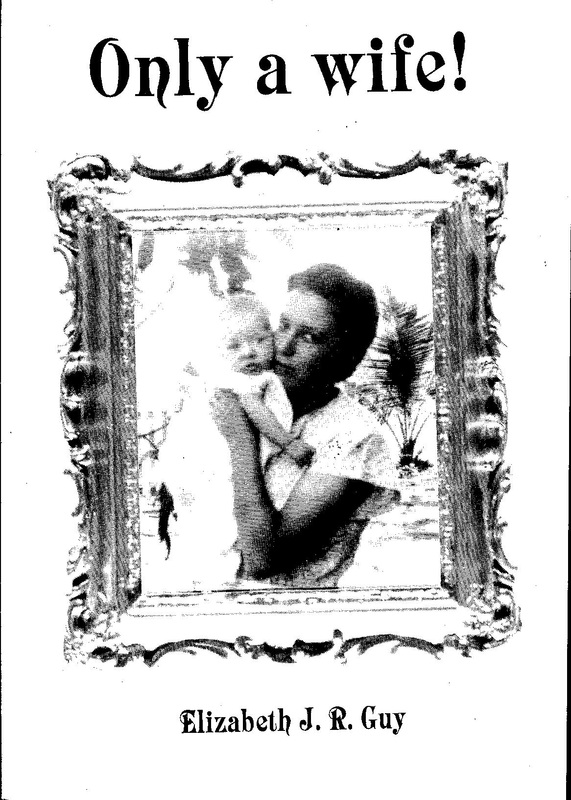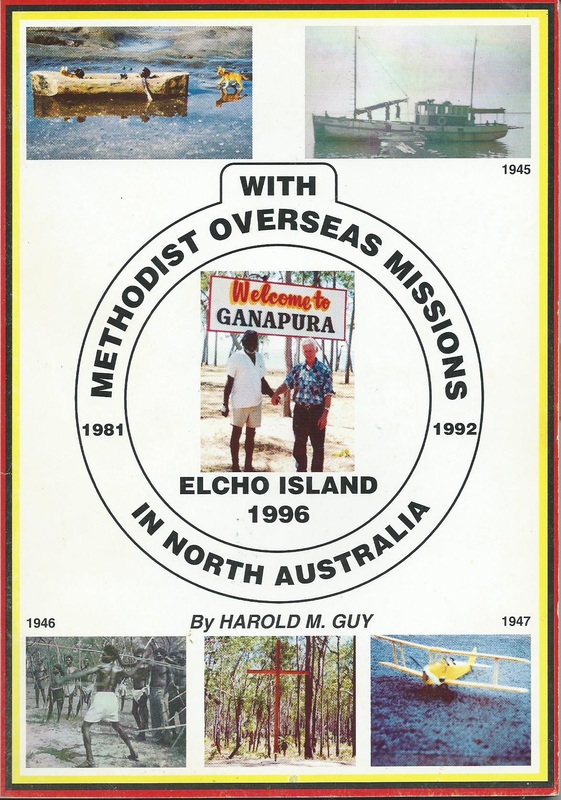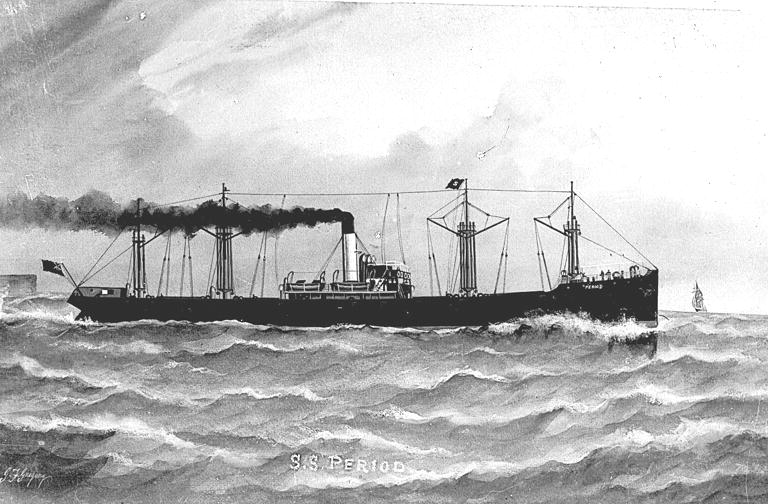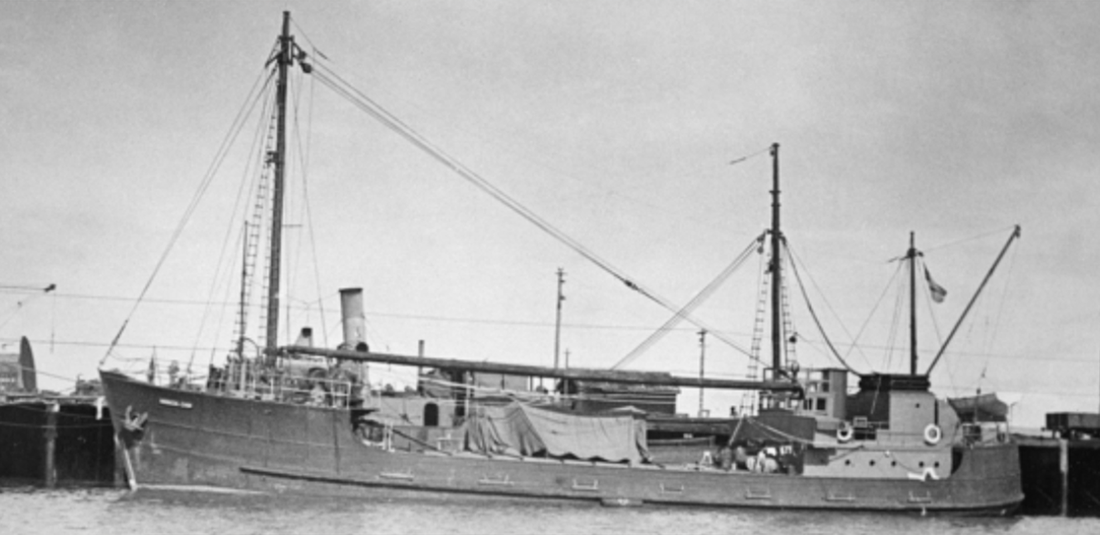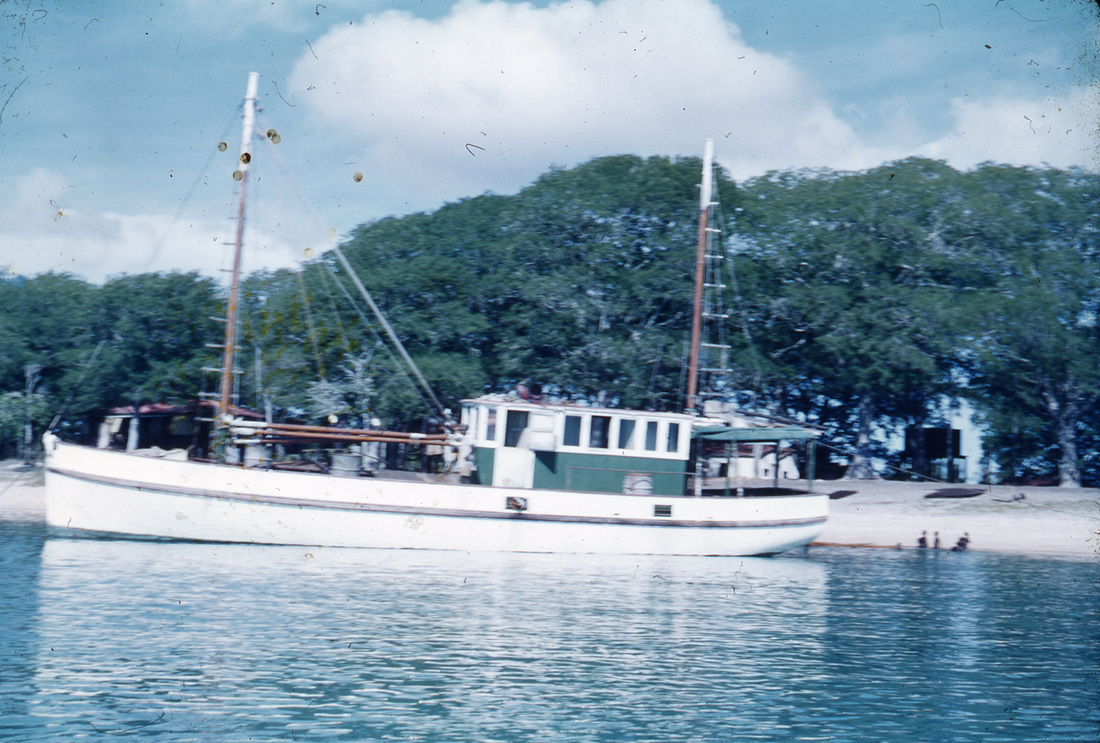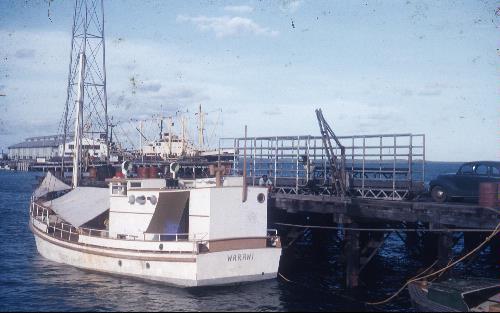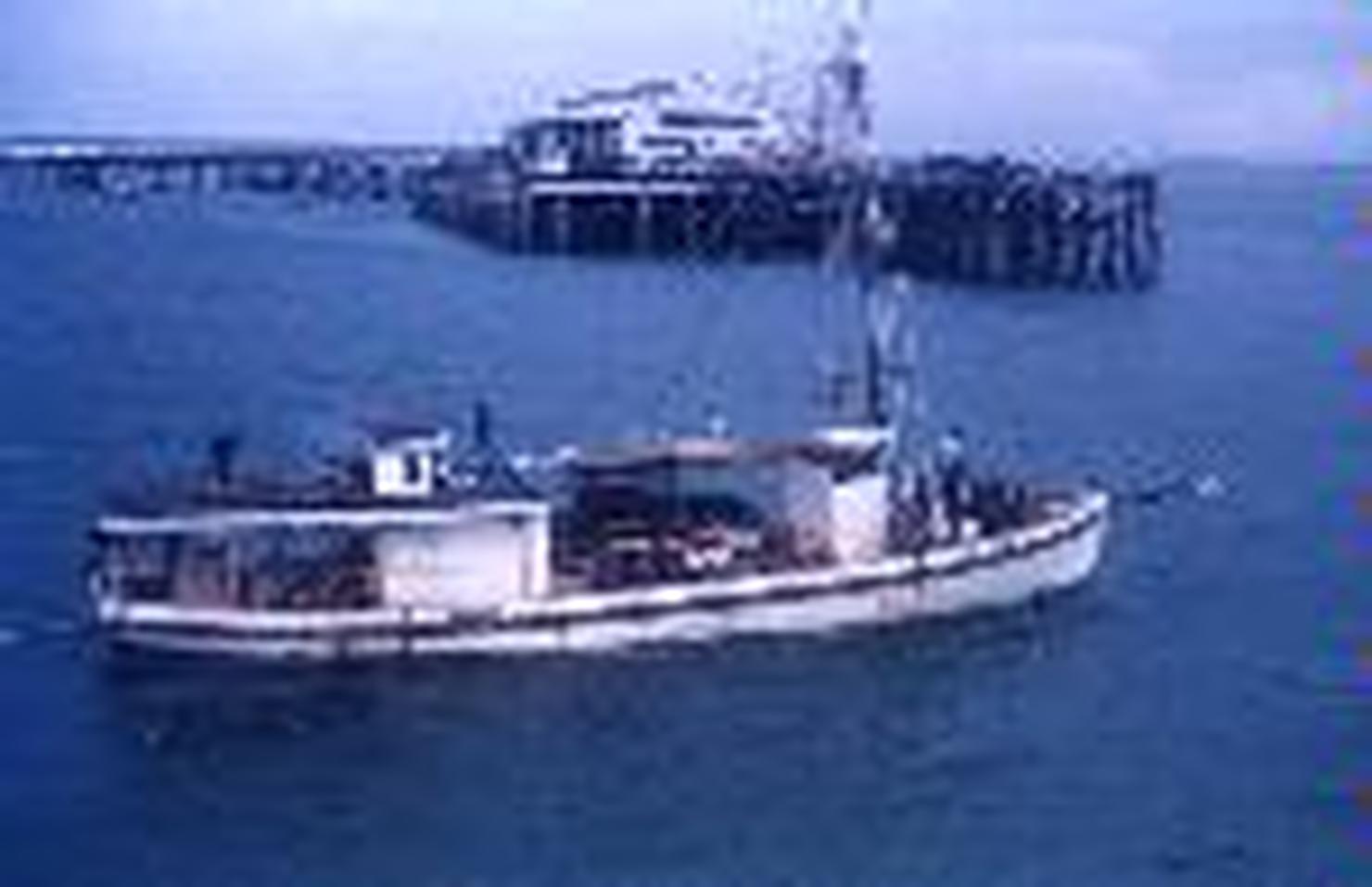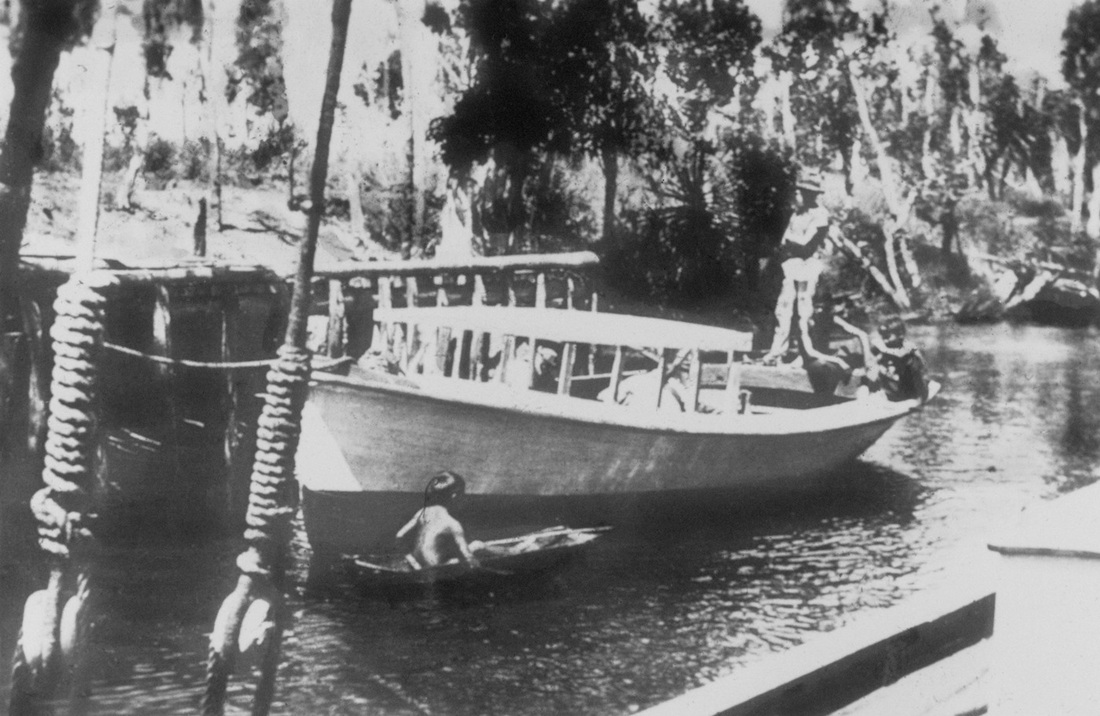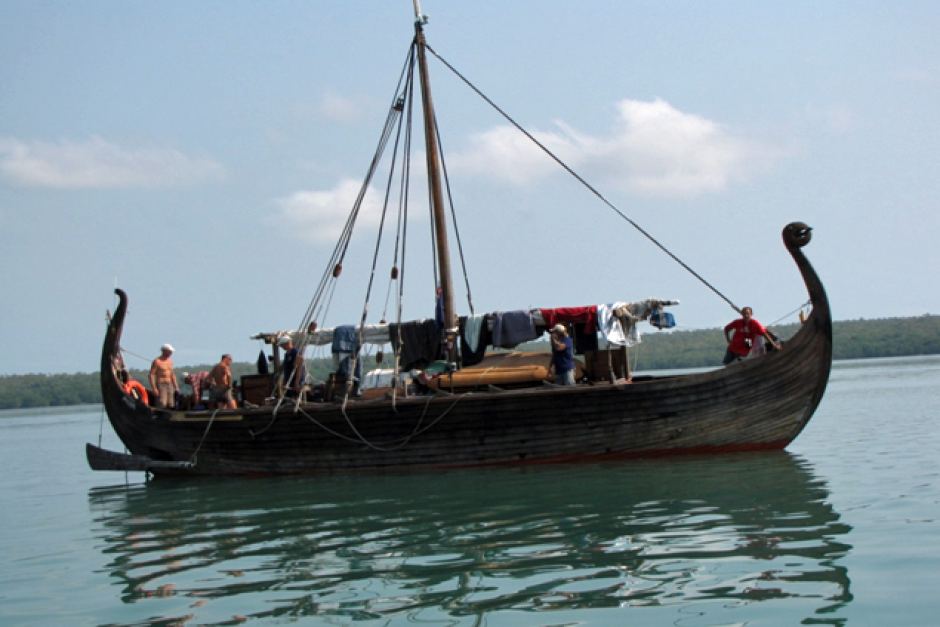A Pictorial History of
ELCHO ISLAND
Sunset over Mission Beach - the permanent freshwater spring was called Takkerena long ago by the Macassans - it means Music Room & covers the adjacent area of the old mission. Howard Is. to the left - Abbott Is. at centre - Milingimbi & Crocodile Islands beyond. To right are rails to build, launch & unload Galiwin'ku Seafoods boats - beyond were fish processing buildings & atop headland is the old Naphtha oil drilling site.
Historical Timeline
|
Mariners & the Wessel Islands
1623 Dutch VOC vessel Arnhem, (a Portuguese prize) under command of Willem Joosten Van Colster (Coolsteerdt), discovers & maps the east coast of Arnhem Land. The green island at centre may indicate the Wessels group as a single island which is how it was depicted before Matthew Flinders. 1636 Dutch ship "Wesel" under command of Pieter Pietersen with the "Klein Amsterdam" sailed south from New Guinea to Cobourg Peninsula and Melville Island. Sailing orders for Gerrit Thomaszoon Pool on 19th February 1636 'we desire you to sail as quickly as possible from Banda to Arnhem’s and Speultsland, situated between 9 and 13 degrees Southern Latitude, discovered 1623'. 1644 Tasman (also with Arnhem's chart) sailed along the north coast of Arnhem Land. |
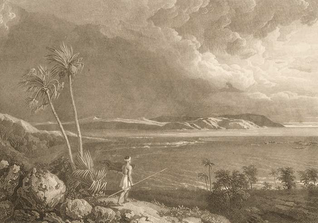 Westall - Macassan fleet at Pobassoo Is. 1803
Westall - Macassan fleet at Pobassoo Is. 1803
Macassans
1675 to 1907 covers the years of the trepang (sea slug) industry as Australia's first international export trade. Possibly some limited earlier visitation & trade in Palm Oil wax for candles etc., turtle shell, pearls & hardwood. Ironstone may have been a combination trade item & ballast.
There are two registered Macasssan processing sites on Elcho - one on Mission Beach and one in Cadell Strait with other sites on the adjacent mainland & islands. The sites classically contain lines of stones to support cauldrons for boiling the trepang, smoke houses for drying, stone-lined wells and graves. The trade was seasonal in the Wet - Makassarese was the lingua franca before English along the Marege Coast - the impact on Yolngu culture & Australia was immense through technology, music, dance and disease - smallpox, venereal & inherited diseases + tobacco & alcohol.
Work on Macassan history began with John Mulvaney and ended with Campbell Macknight whose sentinel work The Voyage to Marege' is critical to understanding the subject. The date given for the commencement of the trade in the last quarter of the seventeenth century is Macknight {VtM pp. 97}. Whilst many anthropologists since Lloyd Warner have touched upon the importance of Macassan influence, it is the Bernts who place the greatest weight thereon. The practice of circumcision, the Javanese drone pipe as well as many linguistic and botanical connections are suggestive of even greater foreign influence. The oral historical tradition of the Yolngu & other groups is clear in refereeing to visitors from the sea prior to the Macassans
1675 to 1907 covers the years of the trepang (sea slug) industry as Australia's first international export trade. Possibly some limited earlier visitation & trade in Palm Oil wax for candles etc., turtle shell, pearls & hardwood. Ironstone may have been a combination trade item & ballast.
There are two registered Macasssan processing sites on Elcho - one on Mission Beach and one in Cadell Strait with other sites on the adjacent mainland & islands. The sites classically contain lines of stones to support cauldrons for boiling the trepang, smoke houses for drying, stone-lined wells and graves. The trade was seasonal in the Wet - Makassarese was the lingua franca before English along the Marege Coast - the impact on Yolngu culture & Australia was immense through technology, music, dance and disease - smallpox, venereal & inherited diseases + tobacco & alcohol.
Work on Macassan history began with John Mulvaney and ended with Campbell Macknight whose sentinel work The Voyage to Marege' is critical to understanding the subject. The date given for the commencement of the trade in the last quarter of the seventeenth century is Macknight {VtM pp. 97}. Whilst many anthropologists since Lloyd Warner have touched upon the importance of Macassan influence, it is the Bernts who place the greatest weight thereon. The practice of circumcision, the Javanese drone pipe as well as many linguistic and botanical connections are suggestive of even greater foreign influence. The oral historical tradition of the Yolngu & other groups is clear in refereeing to visitors from the sea prior to the Macassans
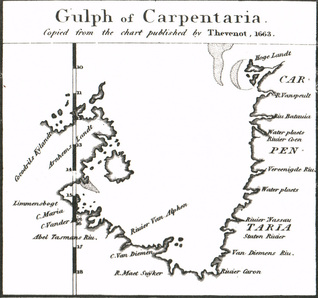 1663 Thevenot part of Flinders Chart NW Gulf 1803
1663 Thevenot part of Flinders Chart NW Gulf 1803
Naming Australia & The Australians
1803 Matthew Flinders sailed Investigator northwards between Cunningham & Warnawi Islands. Flinders named the Wessel Islands "Doubtless what is marked in the Dutch chart as one long Island, and in some charts called Wessels Eylandt, which name I retain with slight modification". In September en route England in the Cumberland Flinders, met Yolngu on Marchinbar Island - he recorded gifting axes to the 'Australians' - his first use of the name.
1819 Abbott Island originally named Rocky Island by PP King in July 1819. Re-named by Captain C.T.G. Haultain of Patrol Boat Larrakia in c1937 after NT Administrator CLA Abbott, a great supporter, who wrote foreword to Haultain’s ‘Watch Off Arnhem Land’.
1867 Capt. Francis Cadell in SS Eagle & SS Firefly named Elcho Island after Lord Elcho of Haddingtonshire, his father's local Member of Parliament. Also Cadell Strait, Napier Peninsular for surveyor Francis Napier & Point Bristow (Nuruwurrunhana) - as First Officer of the "Eagle", Bristow was in charge of 'Firefly'.
1803 Matthew Flinders sailed Investigator northwards between Cunningham & Warnawi Islands. Flinders named the Wessel Islands "Doubtless what is marked in the Dutch chart as one long Island, and in some charts called Wessels Eylandt, which name I retain with slight modification". In September en route England in the Cumberland Flinders, met Yolngu on Marchinbar Island - he recorded gifting axes to the 'Australians' - his first use of the name.
1819 Abbott Island originally named Rocky Island by PP King in July 1819. Re-named by Captain C.T.G. Haultain of Patrol Boat Larrakia in c1937 after NT Administrator CLA Abbott, a great supporter, who wrote foreword to Haultain’s ‘Watch Off Arnhem Land’.
1867 Capt. Francis Cadell in SS Eagle & SS Firefly named Elcho Island after Lord Elcho of Haddingtonshire, his father's local Member of Parliament. Also Cadell Strait, Napier Peninsular for surveyor Francis Napier & Point Bristow (Nuruwurrunhana) - as First Officer of the "Eagle", Bristow was in charge of 'Firefly'.
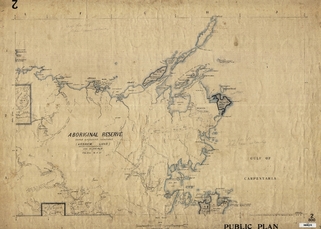 Map of mission leases
Map of mission leases
1st Elcho Island Mission
1921 Rev. Jennison reconnoitres Elcho Island for new Methodist mission - 1st in East Arnhem Land.
1922 Lease of 200 sq. miles of Elcho Island transferred by Mr. A. J. Beckett to the Methodist Missionary Society for cotton cultivation utilising Aboriginal labour.
1st May 1922 - Rev. Jennison & wife land at Elcho to start the mission.
1922 Rev. Jennison finds bitumen which he sends to Dr. Hill (Dentist) in Darwin.
24th October 1922 - Dr. S.E. Hill forms a syndicate and lodges an application for a Mineral Oil & Coal Licence over Elcho Island.
1921 Rev. Jennison reconnoitres Elcho Island for new Methodist mission - 1st in East Arnhem Land.
1922 Lease of 200 sq. miles of Elcho Island transferred by Mr. A. J. Beckett to the Methodist Missionary Society for cotton cultivation utilising Aboriginal labour.
1st May 1922 - Rev. Jennison & wife land at Elcho to start the mission.
1922 Rev. Jennison finds bitumen which he sends to Dr. Hill (Dentist) in Darwin.
24th October 1922 - Dr. S.E. Hill forms a syndicate and lodges an application for a Mineral Oil & Coal Licence over Elcho Island.
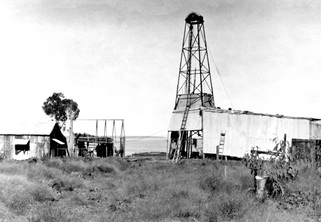
Oil Exploration - Relocation of Mission to Milingimbi
1923 The Elcho Island Naphtha Petroleum Company Limited begin drilling “within sight of the Mission house” - on the hill between the current water tanks & the current clinic.
1923 Elcho Mission closes - house and buildings constructed by J.C. Markey relocated to Milingimbi under Rev. Watson who left Milingimbi 1926 & died in 1946.
March 1926 oil drilling ceases at Elcho. Without the mine there would have be no Milingimbi Mission & no Ramingining community - perhaps no Arnhem Land Reserve. For 20 years Milingimbi was the centre of Mission activity, agriculture, milling, building, health, education and homelands development until WWII.
1923 The Elcho Island Naphtha Petroleum Company Limited begin drilling “within sight of the Mission house” - on the hill between the current water tanks & the current clinic.
1923 Elcho Mission closes - house and buildings constructed by J.C. Markey relocated to Milingimbi under Rev. Watson who left Milingimbi 1926 & died in 1946.
March 1926 oil drilling ceases at Elcho. Without the mine there would have be no Milingimbi Mission & no Ramingining community - perhaps no Arnhem Land Reserve. For 20 years Milingimbi was the centre of Mission activity, agriculture, milling, building, health, education and homelands development until WWII.
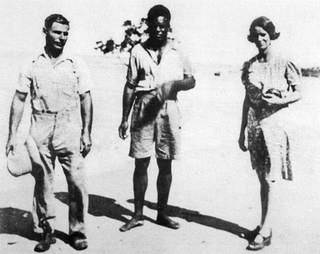 Harold & Ella Shepherdson (with Aminiasi) leaving Milingimbi for Elcho Island.
Harold & Ella Shepherdson (with Aminiasi) leaving Milingimbi for Elcho Island.
Wartime - the 2nd Elcho Island Mission
3rd August 1942 mission lugger Larrpan (Morning Star) & punt carrying tractor loaded at Milingimbi for move to Elcho Is.
8th August 1942 lugger carried to Elcho Island Ella Shepherdson, equipment & people from temporary war hideout camp Wurralnura up Woolen River - 10 miles from Milingimbi.
19th May 1942 RAAF Gannet crashed on Gurrumurru floodplain and began 33 Days raft by crew to Elcho where rescued by aboriginals.
22nd January 1943 HMAS Patricia Cam bombed by Japanese flying boat which landed and picked up Missionary Rev. Len Kentish who became the only Australian captured in Australian home territory during the war.
3rd August 1942 mission lugger Larrpan (Morning Star) & punt carrying tractor loaded at Milingimbi for move to Elcho Is.
8th August 1942 lugger carried to Elcho Island Ella Shepherdson, equipment & people from temporary war hideout camp Wurralnura up Woolen River - 10 miles from Milingimbi.
19th May 1942 RAAF Gannet crashed on Gurrumurru floodplain and began 33 Days raft by crew to Elcho where rescued by aboriginals.
22nd January 1943 HMAS Patricia Cam bombed by Japanese flying boat which landed and picked up Missionary Rev. Len Kentish who became the only Australian captured in Australian home territory during the war.
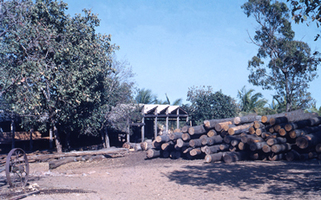 The sawmill epitomised the proud & productive period.
The sawmill epitomised the proud & productive period.
Post-war Golden Age of East Arnhem Land Missions 1945 - 1975
During the mission era Yolngu people managed a thriving fishing industry, a sawmill, vegetable and fruit growing, a mechanical workshop, brickworks and a bakery. People in Galiwin’ku look back to this time with great pride and ask "when can this happen again”.
Over the years these industries have closed as successive waves of Government initiatives have broken on the island. Population has shown strong & consistent growth, far outstripping infrastructure, employment, education and economic development. History & relics of a proud past can define a new community level identity in the post cultural period.
During the mission era Yolngu people managed a thriving fishing industry, a sawmill, vegetable and fruit growing, a mechanical workshop, brickworks and a bakery. People in Galiwin’ku look back to this time with great pride and ask "when can this happen again”.
Over the years these industries have closed as successive waves of Government initiatives have broken on the island. Population has shown strong & consistent growth, far outstripping infrastructure, employment, education and economic development. History & relics of a proud past can define a new community level identity in the post cultural period.
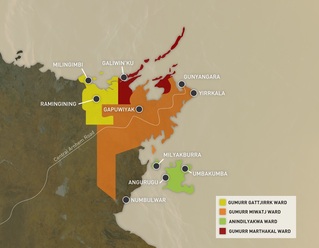 2008 Wards structure - Marthakal remains as was.
2008 Wards structure - Marthakal remains as was.
Community Controlled Local Government
Galiwin’ku operated as a mission settlement until 1976 when Arnhem Land became Aboriginal freehold under the Aboriginal Land Rights (Northern Territory) Act. Galiwin’ku Village Council was formalised as Galiwin’ku Community Incorporated in January 1976 - it was subsequently recognised as a Community Government Council under Northern Territory Government legislation.
An NT Local Government Reform program - as part of a national reform agenda - saw the East Arnhem Shire Council established on 1 July 2008. Of the Shire’s 12 Councillors, three represent the Gumurr Marthakal Ward in which Galiwin’ku is located. Local Boards operated in each community.
Subsequently, the Shire has been renamed a Regional Council echoing the 1990's ATSIC strucuture and more voice is being given to the community through its Local Authority.
Galiwin’ku operated as a mission settlement until 1976 when Arnhem Land became Aboriginal freehold under the Aboriginal Land Rights (Northern Territory) Act. Galiwin’ku Village Council was formalised as Galiwin’ku Community Incorporated in January 1976 - it was subsequently recognised as a Community Government Council under Northern Territory Government legislation.
An NT Local Government Reform program - as part of a national reform agenda - saw the East Arnhem Shire Council established on 1 July 2008. Of the Shire’s 12 Councillors, three represent the Gumurr Marthakal Ward in which Galiwin’ku is located. Local Boards operated in each community.
Subsequently, the Shire has been renamed a Regional Council echoing the 1990's ATSIC strucuture and more voice is being given to the community through its Local Authority.
GEOLOGICAL HISTORY
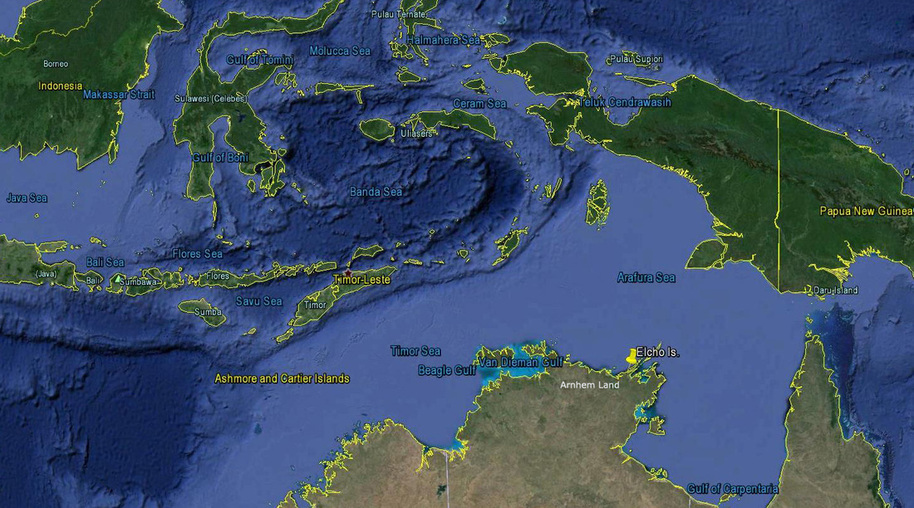
The First Half a Billion Years
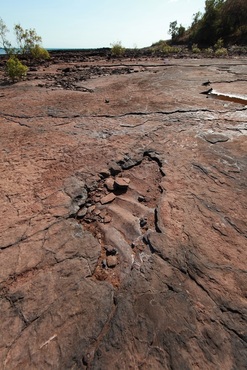
The story of Elcho Island is a tapestry of time woven into
the fabric of Mission Beach, within a few minutes’ walk of Shepherdson College
and the Galiwin'ku community. It is revealed thanks to the knowledge and generosity of Geologist Dr. Andrew
Wygralak of the NT Geological Survey; Geomorphologist/Geochronologist Dr Tim
Stone and eminent palaeontologist Dr Eric Roberts of James Cook University who
dated the beach & identified some tracks & traces. The area is an excellent candidate for research.
Five hundred million years ago Mission Beach was the estuary of a great river that tumbled down from a vast mountain range to the far north-west, somewhere above today’s Banda Sea whose caldera-like rim of rich volcanic Spice Islands is clearly visible on Google Earth from 4,000 Kms above Australia.
As the mountains eroded, the river system carried billions of tons of sediments to settle as estuary sands - vibrated by the rushing waters into the familiar echoing ripples of the sea floor, like the corrugations on a dirt road. The ripples tell of a fast flowing river similar to those in New Zealand today - though on a far grander scale.
At this time (500-547ma) there were no large land animals, life was just beginning to emerge from the sea and the warm shallow sands were full of burrowing creatures whose tracks and tunnels are everywhere apparent. These images show some that have been identified by Prof. Eric Roberts, however the large marks like leaves or splayed muscle shells are not identified.
Five hundred million years ago Mission Beach was the estuary of a great river that tumbled down from a vast mountain range to the far north-west, somewhere above today’s Banda Sea whose caldera-like rim of rich volcanic Spice Islands is clearly visible on Google Earth from 4,000 Kms above Australia.
As the mountains eroded, the river system carried billions of tons of sediments to settle as estuary sands - vibrated by the rushing waters into the familiar echoing ripples of the sea floor, like the corrugations on a dirt road. The ripples tell of a fast flowing river similar to those in New Zealand today - though on a far grander scale.
At this time (500-547ma) there were no large land animals, life was just beginning to emerge from the sea and the warm shallow sands were full of burrowing creatures whose tracks and tunnels are everywhere apparent. These images show some that have been identified by Prof. Eric Roberts, however the large marks like leaves or splayed muscle shells are not identified.
The beaches of the Wessel Islands are noted for
their red rocks which get their colour from the rusting of iron. This
oxidisation became possible once the planet had an atmosphere heavy with oxygen
created by colourful single-celled organisms called Cyanobacteria (blue/green
algae). Countless trillions of these tiny creatures are preserved as pillars
with cauliflower tops called Stromatolites (layered rock) that can be seen at
Rum Jungle south of Darwin and underwater at Shark Bay in
Western Australia.
The sacred rocks to the south of Mission Beach to the east of Dhambala outstation and up a Gawa outstation, owe their reddish hue to these tiny creatures which are the earliest form of life in the fossil record.
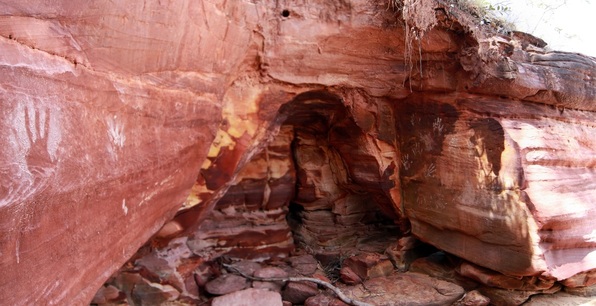
There was no larger life on Earth when layer upon thin layer of river sediment formed the Arnhem Land plateau - as the mountains eroded, the delta grew shallower & wider. The sands turned to sandstone as each new layer of sediment increased the weight bearing down on the layers below until, after millions of years, they fused into stone.
The Wessel Islands are outliers of the Arnhem Land plateau. Their bauxite cap protects them from erosion - leaving them as islands seemingly separate but structurally connected. The layers of deposition are visible at the high energy ends of Mission Beach. The same rippled rock can be found near Lake Evella & 250kms to the south-east at Groote Eylandt, where the rippled underside of the overhanging tip of Castle Rock is suspended 55metres above sea level.
The Wessel Islands are outliers of the Arnhem Land plateau. Their bauxite cap protects them from erosion - leaving them as islands seemingly separate but structurally connected. The layers of deposition are visible at the high energy ends of Mission Beach. The same rippled rock can be found near Lake Evella & 250kms to the south-east at Groote Eylandt, where the rippled underside of the overhanging tip of Castle Rock is suspended 55metres above sea level.
The river delta once covered all of Arnhemland - even perhaps across 800kms from Groote Eylandt to Darwin - much larger than the Mississippi Delta in the USA {in the left image below} & nearly 3 times the size of the famous Nile Delta on the Mediterranean coast of north Africa. The NASA Space Shuttle image{below right}clearly showing how closely human life follows the great river through the desert & out to the sea.
At its highest, the ground surface the Top End of the Territory was some 2kms
(1.7 – 2.3) above today’s level - which at 7,000 feet is about the height that
twin-engine light aircraft fly today {e.g. MAF}. Millions of years of weathering have stripped away the
softer rocks leaving behind just the harder sandstone with its silica and bauxite
cap of the Arnhemland Plateau and outlying ranges of hills. As the sea level rose - following the most recent major Ice Age about 9000 years ago - the hill tops became islands until half a billion years after being buried, the fossilised
rippled rock of Mission Beach is once again at sea level. The ripples in the rock merge with the rippled sands of today in mute admiration of the cycle of
eruption & erosion that has sculpted Arnhemland & continues
with every tide to expose long hidden secrets in the Mission Beach laboratory.
Fossils
|
The Middle Cambrian period (around 500mya) saw an explosion of life as levels of Oxygen rose in the oceans. Trilobite fossil beds may be seen on Elcho near Warnga Point and reportedly up at Bible Camp.
"During the course of hydrogeological investigations by Stefanski on Elcho Island in June 1974, an occurrence of fossils near Ularnga Point (shown as Warnga Point on published maps), Elcho Island (Fig. 1), was pointed out by Mr. E. W. Parr of Elcho Island Mission. Samples collected by Stefanski were assigned an early Middle Cambrian age by Miss Joyce Gilbert-Tomlinson (BMR) (unpublished preliminary note). Further samples collected in August 1974 by M. J. Wiltshire on behalf of Champlin Philippines Inc., and S. K. Skwarko (BMR) were determined by Shergold and confirm the Middle Cambrian age." See KA Plumb et al paper below.
| |||||||
The low energy area at the centre of the beach displays the typical gentle slope and low sandy dunes to be found between the high energy rocks and fossilised beach platforms at Bristow Point and Ganapay Cliffs at the northern end. Defining features are the permanent freshwater spring, a second seepage & the outflow of the lagoon. It is this abundant freshwater close to the sea that determined much of the human history of Elcho Island.
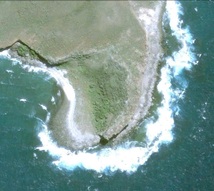
The Quaternary Period {Pleistocene & Holocene Epochs}
In the last two and a half million years there were many episodes when sea levels fluctuated, as the planet cooled then warmed again, sending captive melt water down to swell the oceans. Lifting the great weigh of ice from the land allowed it to rise once again. The Great Ice Ages came and went, carving ‘Glacial Pavements’ deep into the landscape as can be seen on Tipperary Station, south of Darwin. There were, however, countless smaller events with localised effects and some in much more recent times. This Google Earth image shows a stranded beach on Marchinbar Is. - it is now some twenty feet (6metres) above the current relative sea level.
In the last two and a half million years there were many episodes when sea levels fluctuated, as the planet cooled then warmed again, sending captive melt water down to swell the oceans. Lifting the great weigh of ice from the land allowed it to rise once again. The Great Ice Ages came and went, carving ‘Glacial Pavements’ deep into the landscape as can be seen on Tipperary Station, south of Darwin. There were, however, countless smaller events with localised effects and some in much more recent times. This Google Earth image shows a stranded beach on Marchinbar Is. - it is now some twenty feet (6metres) above the current relative sea level.
The Pleistocene
Just 20,000 years ago (18-21ma), the last Ice Age was at its height and Australia was close to its current sub-equatorial position. Dr. Tim Stone says it was a period of extreme cold and aridity when the red Simpson Desert sand dunes of Central Australia dominated the landscape from northern Tasmania to Papua New Guinea. These east-west dunes can be found today where they collide with the beach aligned coastal dunes. The fine, red ‘builders’ sand is much prized and may be clearly seen in the quarry behind the Galiwin’ku community on the back road to the airstrip.
Just 20,000 years ago (18-21ma), the last Ice Age was at its height and Australia was close to its current sub-equatorial position. Dr. Tim Stone says it was a period of extreme cold and aridity when the red Simpson Desert sand dunes of Central Australia dominated the landscape from northern Tasmania to Papua New Guinea. These east-west dunes can be found today where they collide with the beach aligned coastal dunes. The fine, red ‘builders’ sand is much prized and may be clearly seen in the quarry behind the Galiwin’ku community on the back road to the airstrip.
During this time much of the world’s water was
captive to the extended Polar ice caps. The sea was some 150 meters below
today’s level and the Wessel Islands would have been seen as a distant range of
bauxite capped sandstone hills by Aboriginal people as they spread out across
the great Carpentaria plain after crossing the land bridge between Papua New
Guinea and Cape York.
The Holocene
10,000 years ago (11.5 – 8.5) - at the beginning of the Holocene epoch which runs to the present day - the Earth began to warm, melting the polar great ice caps and raising sea levels until they stabilised at their current level some 6000 years ago. Arnhem Land’s characteristic flood plains began to form so that by 4000 years ago sufficient freshwater would be trapped inland each year to sustain the great wetlands of Kakadu & the Arafura Swamp, despite occasional salt water incursions. Hunting on the floodplains in the Dry season and retreating to the escarpment in the Wet afforded Aboriginal peoples a highly productive and stable pattern of life, sufficient sustain the highly complex art and cultural landscape.
10,000 years ago (11.5 – 8.5) - at the beginning of the Holocene epoch which runs to the present day - the Earth began to warm, melting the polar great ice caps and raising sea levels until they stabilised at their current level some 6000 years ago. Arnhem Land’s characteristic flood plains began to form so that by 4000 years ago sufficient freshwater would be trapped inland each year to sustain the great wetlands of Kakadu & the Arafura Swamp, despite occasional salt water incursions. Hunting on the floodplains in the Dry season and retreating to the escarpment in the Wet afforded Aboriginal peoples a highly productive and stable pattern of life, sufficient sustain the highly complex art and cultural landscape.
Further to the north the outer islands of the
Wessels chain were about to emerge as Dr. Tim Stone {Past Masters
geomorphologist} explains “the extra weight of the water bearing down on the
edge of the continental shelf caused the small, isolated islands, rocky shoals
and reefs to emerge from the sea, a phenomenon known as hydro-isostatic
rebound. The islands, rocky shoals and reefs slowly began to connect as waves,
currents and wind combined to form beach ridge plains, spits and barrier dunes.
At some point, the transition from hazardous rocky shore to idyllic sandy beach
environment was enough to entice Yolngu from the mainland. We are dating
calcified beach deposits to determine when this change might have happened. Was
it as recently as 1,000 years ago?”
The Past Masters are investigating the possibility of the Little Ice Age of the 17th century briefly re-opening the land bridge to New Guinea which may account for some of the DNA variations in Aboriginal peoples and the otherwise inexplicable Dutch accounts of voyages of such vessels as the Pera & Arnhem {a section of her 1623 chart below left}wherein seasoned ocean-going mariners described the western end of the Torres Strait as a dried-up river mouth when today the tide race is visible from space.
Mission Beach - an open air laboratory
The low energy area at the centre of the beach displays the typical gentle slope and low sandy dunes to be found between the high energy rocks and fossilised beach platforms seen at Point Bristow in the middle distance & the Ganapay Cliffs at the northern end of Mission Beach from where this image was taken. Defining features of Mission Beach are the permanent freshwater spring, a second seepage & the outflow of the lagoon. It is this abundant freshwater, close to the sea, that determined much of the human history of Elcho Island from the arrival of Aboriginal people though to the Macassans & Missionaries of more recent 'historical' times.
THE Pre-MACASSANS
Navigators, Traders & Castaways
The Portuguese
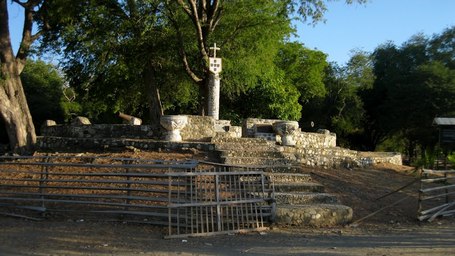 Monument to the 1515 Portuguese landing at Oecussi.
Monument to the 1515 Portuguese landing at Oecussi.
The Portuguese opened the sandalwood trading post at Oecussi in Timor in 1515. Within 50 years the timber was exhausted. Probably at once, but at least by 1550, they would have been purposefully prospecting new sources of sandalwood and other products. Reputedly, there were stands of sandalwood on the Wessels & south of Darwin where there are Tamarind trees & stone fish traps but no usable trepang - only the long black 'fish' that vanish when boiled. The Portuguese built a large canal which is barely discernible today but a major engineering feet in its time. The area is called Panta Makassar {Makassan Beach} where they met the Sulawesi trepang fishermen. Yolngu oral history records the Portuguese as the brokers of the Marege trepang trade with the Chinese. Nagasaki was a Portuguese colony.
The Tiwi Islands off Darwin are 460kms downwind of Timor in the Wet season - the famed Spice Island of Tanimbar is 140kms closer still.
The Tiwi Islands off Darwin are 460kms downwind of Timor in the Wet season - the famed Spice Island of Tanimbar is 140kms closer still.
The Dutch
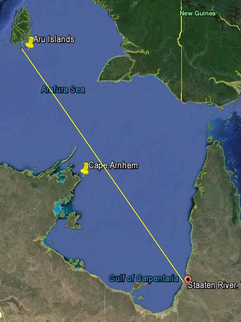
The Pera & Arnhem were Dutch United East-Indies Company VOC {Verenigde Oostindische Compagnie} flagged ships seized as prizes from the Portuguese and sent out in January 1623 - under the command of Jan Carstensz - to search for a passage eastwards to Europe that was reported in 1606 by Willem Jansz (Janszoon) in the ship Dufyken in what is today called the Torres Strait between Papua New Guinea and Cape York. On 22 March the Arnhem dragged her anchor and collided with the Pera - suffering irreparable damage to her rudder. However, using the main-topmast from the Pera and wood from the shore, the carpenters managed to jury-rig a new rudder.
The ships repeated Jansz’s route across the western entrance to the Torres Strait, where he had reported seeing an opening. But Carstensz concluded that it was impossible to sail further east because of the numerous sandbanks and reefs, and that the so-called opening could only be a shallow bay. He named it the ‘de Drooge Bocht’ (the Dry Bend). Geographer Alexander Dalrymple named the strait for Torres - who always maintained that he mapped some islands but made passage to the north of PNG. James Cook got the command that Dalrymple craved and discovered the east coast of his great south land.
The ships repeated Jansz’s route across the western entrance to the Torres Strait, where he had reported seeing an opening. But Carstensz concluded that it was impossible to sail further east because of the numerous sandbanks and reefs, and that the so-called opening could only be a shallow bay. He named it the ‘de Drooge Bocht’ (the Dry Bend). Geographer Alexander Dalrymple named the strait for Torres - who always maintained that he mapped some islands but made passage to the north of PNG. James Cook got the command that Dalrymple craved and discovered the east coast of his great south land.
The Arnhem was under command of "a young man named Willem Joosten Van Colster, second mate in the Pera" who was given command when her master, Drick Melisz(oon) was killed in New Guinea. Arnhem was in such poor condition he decided that the intended long
return route back up the coast of New Guinea was not in his best interests. During the night of 27 April the Arnhem
sailed away from the Pera. Carstensz
wrote in his journal: ‘for on purpose and with malice prepense she cut away
from us against instructions and our resolution, and seems to have set her
course for Aru (to have a good time over there), but we shall learn in time
whether she has managed to reach it’
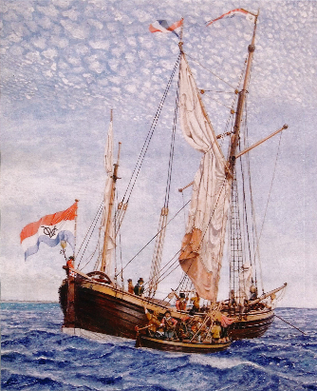 VOC ship Wesel
VOC ship Wesel
The VOC Yacht Cleyn Wesel was prefabricated in Amsterdam & assembled in Batavia (Jakarta- Great Prize). She appears to have had a short career as her design is similar to that of the Thames Barge which operated in coastal waters & rivers. However, for oceanic exploration work she was too wide in the beam and her exposed decks made her unbearable in the tropical heat & unworkable under tropical rains in the Wet.
The Pool Expedition of 1636 echoes much of the voyage of the Pera & Arnhem a decade prior. Commander Gerrit Thomasz Pool was killed in the SW coast of New Guinea on 28th April and succeeded by Pieter Pieterzoon. They had the chart of the Arnhem, a chart by Upper Steersman Arend Martensz de Leeuw (P. 46 Heeres) & other charts Heeres cites in Van Dijk Carpentaria p.37, note 3. In the sailing orders it recounts of the Pera & Arnhem on the eastern shore of the Gulf of Carpentaria and "landed at various places, where they found nothing but barren coasts and lands, and utterly barbarian, cruel, wild natives, who surprised nine of our men fishing, and assassinated the same."
They carried "various kinds of merchandise and minerals which you will show to the people" to ascertain their prevalence and "You will not carry off with you any natives against their will." Pietersen surveyed the newly discovered Arnhem Land for 20 miles from east to west which he unhelpfully named Van Diemensland "we have seen no men, houses, fruit-trees or prows, although we ventured......close along the shore." (Heeres P.71 - The chart is wanting)
The Pool Expedition of 1636 echoes much of the voyage of the Pera & Arnhem a decade prior. Commander Gerrit Thomasz Pool was killed in the SW coast of New Guinea on 28th April and succeeded by Pieter Pieterzoon. They had the chart of the Arnhem, a chart by Upper Steersman Arend Martensz de Leeuw (P. 46 Heeres) & other charts Heeres cites in Van Dijk Carpentaria p.37, note 3. In the sailing orders it recounts of the Pera & Arnhem on the eastern shore of the Gulf of Carpentaria and "landed at various places, where they found nothing but barren coasts and lands, and utterly barbarian, cruel, wild natives, who surprised nine of our men fishing, and assassinated the same."
They carried "various kinds of merchandise and minerals which you will show to the people" to ascertain their prevalence and "You will not carry off with you any natives against their will." Pietersen surveyed the newly discovered Arnhem Land for 20 miles from east to west which he unhelpfully named Van Diemensland "we have seen no men, houses, fruit-trees or prows, although we ventured......close along the shore." (Heeres P.71 - The chart is wanting)
|
| ||||||||||||
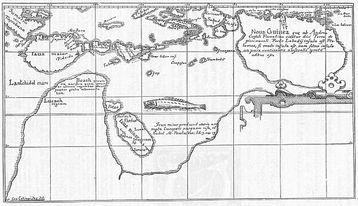 Mercator 1569
Mercator 1569
Early maps such as those above are desperately searched for evidence of early discoveries. Early mapping was entertainment, artistic decoration for the salons of Europe and not intended for navigational purposes. There were no maps of England until 1570 – no maps showing roads until 1690 – indeed there were no formed roads constructed in England for 1500 years between the Romans & the turnpikes of the 18th century. Travel was a dangerous business until comparatively recent times.
The spatial construct of maps fixing relative locations & affording travel between them has not existed for the vast majority of the 5000 years of international trade. From the beginning of the bronze age, when tin was wisely substituted for arsenic, until the advent of seagoing chronometers with Mr. Harrison's time-keeper in 1761 - which was timely for Captain Cook & Flinders and the discovery of Australia.
The spatial construct of maps fixing relative locations & affording travel between them has not existed for the vast majority of the 5000 years of international trade. From the beginning of the bronze age, when tin was wisely substituted for arsenic, until the advent of seagoing chronometers with Mr. Harrison's time-keeper in 1761 - which was timely for Captain Cook & Flinders and the discovery of Australia.
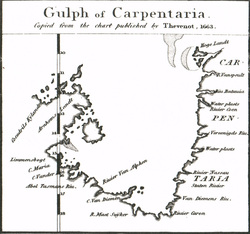
Since the time of Dutch explorer Abel Tasman, the recurrent theme of sailing orders was to try to determine if the Southern Land was one land mass or adjacent islands. This quest took Matthew Flinders down to the Great Australian Bight and up to the Gulf of Carpentaria to prove that no seaway existed between them and so claim discovery of the continent which he named Australia.
Flinders had been able to prove that the unnamed chart published by Thevenot in 1663 was almost certainly the work of Abel Tasman & fairly represented a real voyage, not 'a map of fairy land' that it was thought to be. It was the practice to retain the place names given by previous navigators when confirmed.
The ship Investigator brought Flinders to the Wessel Islands twice in 1803. Whilst not named in Thevenot the large island was variously called Wessel's or Wezel's Eylandt on the Dutch chart - so Flinders retained the name with a small variation as the Wessel Islands.
Flinders had been able to prove that the unnamed chart published by Thevenot in 1663 was almost certainly the work of Abel Tasman & fairly represented a real voyage, not 'a map of fairy land' that it was thought to be. It was the practice to retain the place names given by previous navigators when confirmed.
The ship Investigator brought Flinders to the Wessel Islands twice in 1803. Whilst not named in Thevenot the large island was variously called Wessel's or Wezel's Eylandt on the Dutch chart - so Flinders retained the name with a small variation as the Wessel Islands.
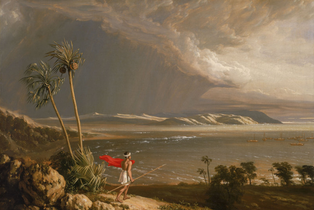
On the 17th February 1803 Matthew Flinders met a Macassan fishing fleet at Pobassoo Island which he named for the master of the trepang fleet. From about 1670 to 1907 the fishermen came each Wet season from their home port of Makassar on the island of Sulawesi in modern Indonesia.
They would trade metal tools, dugout canoes, clothes, alcohol and tobacco for goods such as pearls, turtle shell and hardwood but their focus was upon the sea cucumber or trepang which was boiled and smoke dried for sale in to the Chinese market.
It was evidently a great surprise to find such a large fleet of foreign ships on Australian shores so that the poor state of his ship may not have been the only motivation to cut short his circumnavigation & sail for Koepang.
They would trade metal tools, dugout canoes, clothes, alcohol and tobacco for goods such as pearls, turtle shell and hardwood but their focus was upon the sea cucumber or trepang which was boiled and smoke dried for sale in to the Chinese market.
It was evidently a great surprise to find such a large fleet of foreign ships on Australian shores so that the poor state of his ship may not have been the only motivation to cut short his circumnavigation & sail for Koepang.
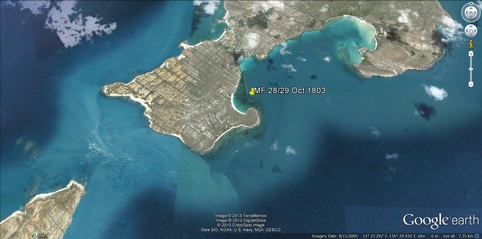
Matthew Flinders made his second visit to the Wessel Islands in the 19 ton schooner Cumberland in October 1803 having lost the Investigator on Wreck Reef on the Great Barrier Reef & sailed a small boat to Sydney to raise the alarm. He then sailed Cumberland to rescue his men.
On course for England he sailed via Torres Straits direct to Cape Wilberforce & on the evening of Friday 28th dropped anchor in the bay on the SE corner of Marchinbar Island. The next morning he was ashore with his men cutting up the wreck of a Macassan prau when visited by some local men (Gurruwiwi?) who wandered down for a chat. In his diary Flinders wrote that on departure he made gifts of the axes to 'the Australians' - the first time that the name was applied to the people of Australia by the man who discovered and named the continent.
On course for England he sailed via Torres Straits direct to Cape Wilberforce & on the evening of Friday 28th dropped anchor in the bay on the SE corner of Marchinbar Island. The next morning he was ashore with his men cutting up the wreck of a Macassan prau when visited by some local men (Gurruwiwi?) who wandered down for a chat. In his diary Flinders wrote that on departure he made gifts of the axes to 'the Australians' - the first time that the name was applied to the people of Australia by the man who discovered and named the continent.
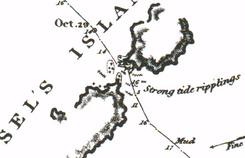 Matthew Flinders 1803 Cumberland Strait
Matthew Flinders 1803 Cumberland Strait
Thanks to Matthew Flinders' younger brother Samuel forgetting to wind the clocks in 1803, there were no accurate charts of the Wessel Islands until the 1990's - which is why 'native pilots' such as Paddy Babawun & Too Dark were vital to Royal Australian Navy ships such as the HMAS Larrakia, HMAS Kuru & HMAS Patricia Cam during the Second World War.
Kuru rescued the survivors of HMAS Pat Cam from an island near the Cumberland Strait which Flinders would have seen clearly as he took his last sight of Australia. The world renowned artist Ian Fairweather lived in the rear end of the wreck of the Kuru in Darwin harbour - hence 'Rear-admiral' - before rafting to Indonesia with six tins of Spam and three bottles of water - he had two tins left on arrival at Roti Island.
Kuru rescued the survivors of HMAS Pat Cam from an island near the Cumberland Strait which Flinders would have seen clearly as he took his last sight of Australia. The world renowned artist Ian Fairweather lived in the rear end of the wreck of the Kuru in Darwin harbour - hence 'Rear-admiral' - before rafting to Indonesia with six tins of Spam and three bottles of water - he had two tins left on arrival at Roti Island.
The Pre-Macassans Resources
|
|
| ||||||||||||||||||
|
|
| ||||||||||||||||||
THE MACASSANS
The term Macassans refers to Muslim fishermen who came from a wide area of what is now Indonesia to crew a fleet of praus which had its home port at Makassar (modern Ujung Pandang) on the island of Sulawesi. The work begun by John Mulvaney was completed by Campbell Macknight, who is the authority on the trade. His exhaustive work - The Voyage to Marege' - is a scholarly & accessible work - a link to his works at ANU is provided below.
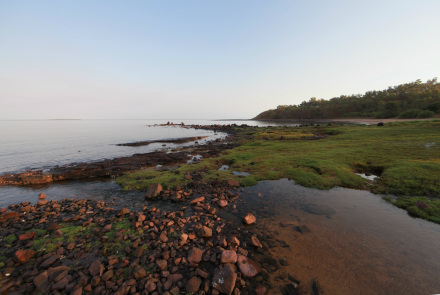
This oasis is Takkerena, the Music Room named by the Macassans who were regular monsoonal visitors to the Marege (black people with curly hair) coast from around the 1670's until 1907 when, after years of decline, new competition and customs duties ended the trade.
The green patch heralds the fresh water that drew the Missionaries & Macassans and many more besides. Freshwater beside the sea is a precursor to Macassan stone lined wells, smoke houses and stonelines.
There is a great wealth of traditional knowledge and historical information that speaks of the centuries of international trade, cultural exchange, material development and robust interaction between Yolngu & Macassans - Australia's first international trading partner.
The reconstruction of a line of stone hearths with timber frames and cauldrons would be simple, cheap and instructional fun.
The green patch heralds the fresh water that drew the Missionaries & Macassans and many more besides. Freshwater beside the sea is a precursor to Macassan stone lined wells, smoke houses and stonelines.
There is a great wealth of traditional knowledge and historical information that speaks of the centuries of international trade, cultural exchange, material development and robust interaction between Yolngu & Macassans - Australia's first international trading partner.
The reconstruction of a line of stone hearths with timber frames and cauldrons would be simple, cheap and instructional fun.
The Start of the Trepang Trade
Macknight (Voyage to Marege' pp97) suggests that Macassan visitation probably started in the last quarter of the 17th century (1675-1700) in a haphazard way - developing to an industrial scale over the next century (i.e. by 1775 -1800). Trepang (beche-de-mer or sea slug) was the focus of trade but anything of value would have been taken including pearls which Aboriginal people would collect during the Dry - wax for candles etc. from boiling down the abundant palm trees which extend south of Darwin where the only trepang are the skinny black type which vanish when boiled - hardwood was popular and there may have been some initial interest in stone tools as antique curios.
Legend has it that a shipwrecked Macassan fisherman washed up on the Arnhemland shore and discovered the trepang beds. Ships continue this involuntary transgression today as the NW trade wind is steady, distance is short & Australia a big target. Coburg Peninsular is a popular landing spot as is Roti for those doing the northwards leg - as demonstrated by Ian (Rear-Admiral) Fairweather & more recently by orange lifeboats.
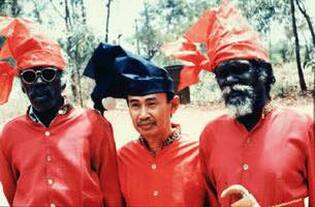
Ian McIntosh writes that in the latter half of the 1980s, the late Warramirri leader George Liwukang of Elcho Island (right) greeted a visitor from Makassar who had sailed in a replica of those traditional vessels that had made the annual journey to NE Arnhem Land in search of trepang and other trade goods.
This trade began in the mid-1700s but Macassans and other Indonesians had visited Arnhem Land well before this - and there is strong evidence that there was a major Indonesian base on Australian shores in the mid 1600s that lasted at least a generation.
Image - shows L>R Charlie Matjuwi Burrawanga - Sirajuddin Bantang (aka Daeng Bantang) & George Liwukang.
This trade began in the mid-1700s but Macassans and other Indonesians had visited Arnhem Land well before this - and there is strong evidence that there was a major Indonesian base on Australian shores in the mid 1600s that lasted at least a generation.
Image - shows L>R Charlie Matjuwi Burrawanga - Sirajuddin Bantang (aka Daeng Bantang) & George Liwukang.
Macassan contact in the framework of Muslim Australian history by Regina Ganter. The last phase of Macassan–Yolngu contact was still accessible to oral history when Campbell Macknight and Peter Spillett were conducting fieldwork in the 1960s and 1970s. Macknight, working under the supervision of Professor John Mulvaney, began to rediscover some of the names of Indonesian captains in the customs records, and matched them with names remembered in various stories told by Yolngu. He made contact with the family of Husein Daeng Rangka in Makassar, who was the last of the captains who came to Australia and whose career is reflected in the Australian customs records. A 1981 issue of Aboriginal History contained two important essays on the Macassan influence in the Yolngu languages, reflecting linguistic work then being undertaken (Urry and Walsh 1981; Walker and Zorc 1981).
Husein Daeng Rangka and members of his family appear in a range of Yolngu stories, though with different spellings, sometimes difficult to recognise. The Arabic name Husein becomes ‘Using’ or ‘Oesing’ in Indonesian. The ‘Daeng’ in his name devolves from an old honorific title from the ancient Kingdom of Gowa on Sulawesi and is widespread in Makassar (Macknight 1976b). It was also devolved to some of their Aboriginal relatives and trading partners in Australia where it appears as the prefix ‘Dayn’ in Yolngu names. Husein Daeng Rangka had at least two Aboriginal wives (Macknight 1976a). He is also reported to have abducted a wife of Ganimbirrngu, who was the leader at Melville Bay (Lembana Panrea in Yolngu territory). The Macassans referred to the latter as the ‘raja of Melville Bay’, and Husein Daeng Rangka bestowed on him the name of Dayngmangu (Macknight 1976b, p. 84). This was the father of David Burrumarra, informant for most researchers conducting fieldwork there until the 1980s. The family connections are closely woven.
Peter Spillett from the Northern Territory Museum instigated a bicentennial project to reconstruct a traditionally crafted perahu padewakang, the type of boat used in the trepang trade, to sail once more from Makassar to the Top End of Australia, known by the Macassans as Marege’. He accompanied the Batchelor College students on a visit to Makassar in 1986, at which time it was called Ujung Pandang. They were amazed at the similarity in language, expressions and names they encountered. They felt as if old legends were coming alive in front of them, to see the characteristic sails, men wearing the songkok caps, also known as peci, as well as all the iconography from the paintings at home. Based on discussions with several of these students, it was evident that they felt great amazement that the Mangathara (Yolngumatha for Macassans) of the old stories really existed (see also Spillett 1987). It was only a few years since the last of the known travellers to Australia had died, in 1978, Mangnellai Daeng Maro. As a boy of about ten, he had accompanied his father, Husein Daeng Rangka, to Australia.
The Hati Marege bicentennial project caused a flurry of negative media reportage because the Northern Land Council had objected to the flying of the bicentennial flag on the prau, arguing that this history had nothing whatsoever to do with the bicentennial or the arrival of the British anywhere in Australia. The Indonesian and Australian diplomats involved were faced with the possibility of a hostile reception or a cancelled event. It became a tussle about who owns this history. The Hati Marege sailed into Yirrkala precisely 200 years after the First Fleet reached Botany Bay (16 January 1988), captained by Mansjur Muhayang, a great-grandson of Husein Daeng Rangka. He handed over a bag of rice like in olden times, and was greeted by Matjuwi Burrawanga from Galiwin’ku at Elcho Island as a family member. This bicentennial project was understood as a family reunion, and was surely the single most successful bicentennial project. With it, the Yolngu people broke the isolation that had severed them from friends and relations in 1906. (http://press.anu.edu.au/apps/bookworm/view/Macassan+History+and+Heritage/10541/ch04.xhtml)
Husein Daeng Rangka and members of his family appear in a range of Yolngu stories, though with different spellings, sometimes difficult to recognise. The Arabic name Husein becomes ‘Using’ or ‘Oesing’ in Indonesian. The ‘Daeng’ in his name devolves from an old honorific title from the ancient Kingdom of Gowa on Sulawesi and is widespread in Makassar (Macknight 1976b). It was also devolved to some of their Aboriginal relatives and trading partners in Australia where it appears as the prefix ‘Dayn’ in Yolngu names. Husein Daeng Rangka had at least two Aboriginal wives (Macknight 1976a). He is also reported to have abducted a wife of Ganimbirrngu, who was the leader at Melville Bay (Lembana Panrea in Yolngu territory). The Macassans referred to the latter as the ‘raja of Melville Bay’, and Husein Daeng Rangka bestowed on him the name of Dayngmangu (Macknight 1976b, p. 84). This was the father of David Burrumarra, informant for most researchers conducting fieldwork there until the 1980s. The family connections are closely woven.
Peter Spillett from the Northern Territory Museum instigated a bicentennial project to reconstruct a traditionally crafted perahu padewakang, the type of boat used in the trepang trade, to sail once more from Makassar to the Top End of Australia, known by the Macassans as Marege’. He accompanied the Batchelor College students on a visit to Makassar in 1986, at which time it was called Ujung Pandang. They were amazed at the similarity in language, expressions and names they encountered. They felt as if old legends were coming alive in front of them, to see the characteristic sails, men wearing the songkok caps, also known as peci, as well as all the iconography from the paintings at home. Based on discussions with several of these students, it was evident that they felt great amazement that the Mangathara (Yolngumatha for Macassans) of the old stories really existed (see also Spillett 1987). It was only a few years since the last of the known travellers to Australia had died, in 1978, Mangnellai Daeng Maro. As a boy of about ten, he had accompanied his father, Husein Daeng Rangka, to Australia.
The Hati Marege bicentennial project caused a flurry of negative media reportage because the Northern Land Council had objected to the flying of the bicentennial flag on the prau, arguing that this history had nothing whatsoever to do with the bicentennial or the arrival of the British anywhere in Australia. The Indonesian and Australian diplomats involved were faced with the possibility of a hostile reception or a cancelled event. It became a tussle about who owns this history. The Hati Marege sailed into Yirrkala precisely 200 years after the First Fleet reached Botany Bay (16 January 1988), captained by Mansjur Muhayang, a great-grandson of Husein Daeng Rangka. He handed over a bag of rice like in olden times, and was greeted by Matjuwi Burrawanga from Galiwin’ku at Elcho Island as a family member. This bicentennial project was understood as a family reunion, and was surely the single most successful bicentennial project. With it, the Yolngu people broke the isolation that had severed them from friends and relations in 1906. (http://press.anu.edu.au/apps/bookworm/view/Macassan+History+and+Heritage/10541/ch04.xhtml)
|
|
| ||||||||||||||||||
|
|
| ||||||||||||||||||
The First Mission 1922
"The lease of Elcho was recently transferred by Mr. A. J. Beckett to the Methodist Mission, who it is understood, propose embarking upon a cotton cultivation scheme on a fairly extensive scale with aboriginal labour, Mr. J. C. Markey, builder and contractor, having been engaged for some months past in the erection of the necessary quarters and sheds."
"The island is populated by several hundred natives, who until visited several years ago by the then Chief Inspector of Aborigines, Mr. J. T. Beckett, were hostile and very dangerous. Several beach prospectors were killed by them, and Macassar graves on the island prove the feuds that existed between the islanders and the invading race. Less than a year ago Mr A. J. Beckett transferred the lease of the island to the Methodist Mission. Bitumen and other oil indication were then discovered. The natives called the bitumen fire stone. The natives on Elcho Island are not now nearly so numerous as they were in years gone by. They have been constantly attached by a powerful mainland tribe, who have paid surprise visits to the island, killed off the young warriors and old people; and stolen the women and children. The English Company's Islands, further NE, have been practically depopulated by tribal war. Elcho Island and other islands of the Wessel group, are for the most part fertile and well-timbered. For the growth of cotton and other tropical plant produce they are well adapted. Cypress pine is abundant, and good hardwoods abound." Northern Standard, Darwin, NT - Tuesday 9 January 1923
"The island is populated by several hundred natives, who until visited several years ago by the then Chief Inspector of Aborigines, Mr. J. T. Beckett, were hostile and very dangerous. Several beach prospectors were killed by them, and Macassar graves on the island prove the feuds that existed between the islanders and the invading race. Less than a year ago Mr A. J. Beckett transferred the lease of the island to the Methodist Mission. Bitumen and other oil indication were then discovered. The natives called the bitumen fire stone. The natives on Elcho Island are not now nearly so numerous as they were in years gone by. They have been constantly attached by a powerful mainland tribe, who have paid surprise visits to the island, killed off the young warriors and old people; and stolen the women and children. The English Company's Islands, further NE, have been practically depopulated by tribal war. Elcho Island and other islands of the Wessel group, are for the most part fertile and well-timbered. For the growth of cotton and other tropical plant produce they are well adapted. Cypress pine is abundant, and good hardwoods abound." Northern Standard, Darwin, NT - Tuesday 9 January 1923
Milingimbi had been recommended by Rev. Watson as the site for the second Methodist Mission in Arnhemland. However, the Rev. JC Jennison - then Chairman of the North Australia District of Methodist Overseas Mission - favoured an "industrial mission" and resolved to take the lease on Elcho Island from Mr Beckett and on 1st May 1922 the Rev. & Mrs Jennison arrived at Elcho to establish the mission, centred upon the cultivation of cotton utilising Aboriginal labour - there being a world wide shortage of cotton at the time. There were about 180 Aboriginal people at Elcho who responded well to the presence of the mission and the dole of a pannikin of flour for breakfast each day. Jennison trumpeted that "The Chief Warden of Mines in the Northern Territory has openly declared that the establishment of Elcho Mission Station has been productive of much good among the natives. This extends for a radius of quite 60 miles from the island and he stated that he had been able to undertake trips into the interior that would have been impossible before our establishment.”
- Return of the John Alce - A Protracted Voyage - 1922
.......Mr Markey has been engaged since April last, in the erection of buildings on Elcho Island, for the Methodist Missionary Society of Australia, and his experiences there are worth recording. He landed on the island simultaneously with the Rev. J C Jennison, Mr Hamer, the wives of the gentlemen mentioned, and their three tiny children. The boats used for the transport of the party, and the necessary materials, were the John Alce, the lugger Lily and the mission schooner McBride. When the disembarkation commenced, the island was devoid of shelter, and the party had to content themselves with scant comfort. Conditions improved as the work of building progressed, and today the mission is provided with a modern abode, replete with every possible convenience. The building, erected on substantial concrete piers, measures, overall, sixty by forty-two feet, and is provided with a roomy veranda. When fully equipped, the station will have a dormitory for native children, as well as a school, house and hospital. In the latter direction the Rev. Jennison, has already accomplished good, but much remains to be done.
The ranks of the island natives, numbering between two and three hundred, have been decimated by a dire scourge, the effects of which are still visible on both old and young. Mr Markey gives a harrowing description of some of the sufferers, who in their appalling ignorance, are indifferent to the consequences of the disease. With these unfortunates, as well as seven blind men, and twelve deaf and dumb children, the Rev. Jennison and his assistants will have nearly enough to occupy their minds. Missionaries however have accomplished wonders in the way of work, before to-day, and if those connected with the new venture, succeed in alleviating the distress of these people, while attending their other duties as well, they will earn praise, and deserve special recognition.
The normal Elcho Island aboriginal is, according to Mr Markey, just the ordinary type, with the migratory instinct well developed......Instances of marked intelligence among the younger section are by no means rare, and the mission is full of hope for the future. Some of the tribes on the nearby mainland, are believed to be more or less exogamous, and their periodic visits to Elcho are fraught with danger. One such visit during Mr Markey's stay there, caused him considerable concern and resulted in a mimic warfare. The mainland men on this occasion made a demonstration in the vicinity of the mission camp, and the discharge of firearms was necessary to drive them off.......
Since then the settlers have not been troubled and the work of clearing the bush for cotton and other cultivation is proceeding satisfactorily. In this task the mission is assisted by two Bardoons (South Sea Island mission boys). Under their supervision, the natives are helping to make the branch self-sustaining. They are improving their own condition at the same time, as well as their children, whose interests are specially guarded by the Rev Jennison and his staff.
..... The only other European, in the immediate vicinity of Elcho Island, is Mr Bob Moy, engaged in - the trepang industry.
The Queensland cotton expert, Mr. D. Jones, claims that Australia is more suited to the growth of cotton than any other part of the universe. If this sweeping statement contains even a substratum of truth, the future prosperity of the Territory is assured.
A False Dawn
Jennison was a Fellow of the Royal Society of South Australia. During an afternoon stroll along the beach, he found bitumen at Point Bristow is two and a half kilometres from the site of the mission station which was located directly behind the beach spring known as Takkerena. It is only 250 metres further north to the beach below the mine site at the Ganapay Cliffs. Jennison was attracted by the glitter of the freshly fractured sample and at the mission house he proved it to be bitumen by simple tests. Subsequently, Jennison sent the bitumen to Darwin dentist Dr. Hill via the 33 ton auxiliary ketch John Alce which the Government kindly purchased from Paddy Cahill in 1917. In 1926 the vessel was sold to the Boucaut Bay Company which would become the central feature of the ensuing saga.
Upon receipt of the bitumen samples a fever of expectation saw a mining syndicate formed. In August, a prospecting party arrived on the island, under E.P. Zakharow, who confirmed the existence of bitumen & reported so favourably upon the prospect of finding oil that the Elcho Island Naphtha Petroleum Company was formed at once and a licence secured in October - drilling began in May of the following year within sight of the mission.
The Mission buildings were offered to the mine but rejected on the grounds that the house afforded an unrealistic degree of luxury that could not be provided for the other workers. The house & sheds built by Mr Markey were relocated to Milingimbi where the new mission began under Rev. Watson who was appointed to replace Jennison, who returned south for family reasons. Watson did not wait for the results of the test drilling but abandoned Elcho, and relocating to his preferred site at Milingimbi This triggered a bitter feud between the men that culminated in a public slanging match over allegations of brutal treatment of the natives by Watson that supposedly precipitated the spearing of Webb & Robertson. The scandalous mirage of missionaries shooting & whipping the natives was entirely eclipsed by the nation-wide coverage of the shenannigans surrounding the Naphtha Petroleum Company and when drilling ceased on Elcho in March 1926, having found only water - the company was aptly liquidated & the licence cancelled in November of that year.
The oil drilling was a pivotal event in Arnhemland history as the first & only substantial oil drilling venture and although a failure, it was directly responsible for the founding of Milingimbi Mission, the Shepherdsons, Webb, Lloyd Warner and all the significant identities therein. Without the mine there would have been no Ramingining Community & homelands - no WWII RAAF forward air base, which would likely have been built on Elcho thus forcing evacuation to the mainland & perhaps abandonment of the area which in turn could have seen the post-war dissolution of the Arnhem Land Reserve.
The Naphtha Petroleum Company's Elcho Island venture was the first act in an epic saga of deceit, avarice, corrupt officials and bent politicians in the finest traditions of the form. Expectations, funds and exploration companies were raised across the Top of Arnhemland from Boucaut Bay to Bickerton Island. Government funds were extracted, public opinion & investor confidence were manipulated though bogus geological reports - dodgy share dealings & outrageous claims such as the two white women held captive by wild Arnhemland Aboriginals after the loss of the Douglas Mawson. A drama which began as the Huddersfield Expedition & ended with the Prime Minister defending his ministers in the house against allegations of widespread corrupt.
The popular hysteria inflamed by the preposterous Mawson Affair fed directly into the public outcry over the killing of Japanese trepangers & soon after the murder of beachcombers Fegan & Traynor. The subsequent Police Party resulted in the death of Constable McColl - speared by Tuckiar on Woodah Island - the clamour for punitive action & the Caledon Bay Peace Expedition - Donald Thomson's involvement along with Fred Gray of Umbakumba; Alf Dyer of Oenpelli; Bill Harney the patrol officer & author - the show trial in Darwin and obliged the Methodists to start Yirrkala mission after the Anglicans jumped the fence & built a church on the mainland. The publicity & public awareness suited post war political alignment to pax Americana in the American-Australian Scientific Expedition and supported the continuation of the Arnhem Land Aboriginal Reserve. The publicity drove a wider interest in Aboriginal art (wider than just Mountford) - health & education issues became ideological causes and Arnhemland culture came at last to define Aboriginal Australia.
Upon receipt of the bitumen samples a fever of expectation saw a mining syndicate formed. In August, a prospecting party arrived on the island, under E.P. Zakharow, who confirmed the existence of bitumen & reported so favourably upon the prospect of finding oil that the Elcho Island Naphtha Petroleum Company was formed at once and a licence secured in October - drilling began in May of the following year within sight of the mission.
The Mission buildings were offered to the mine but rejected on the grounds that the house afforded an unrealistic degree of luxury that could not be provided for the other workers. The house & sheds built by Mr Markey were relocated to Milingimbi where the new mission began under Rev. Watson who was appointed to replace Jennison, who returned south for family reasons. Watson did not wait for the results of the test drilling but abandoned Elcho, and relocating to his preferred site at Milingimbi This triggered a bitter feud between the men that culminated in a public slanging match over allegations of brutal treatment of the natives by Watson that supposedly precipitated the spearing of Webb & Robertson. The scandalous mirage of missionaries shooting & whipping the natives was entirely eclipsed by the nation-wide coverage of the shenannigans surrounding the Naphtha Petroleum Company and when drilling ceased on Elcho in March 1926, having found only water - the company was aptly liquidated & the licence cancelled in November of that year.
The oil drilling was a pivotal event in Arnhemland history as the first & only substantial oil drilling venture and although a failure, it was directly responsible for the founding of Milingimbi Mission, the Shepherdsons, Webb, Lloyd Warner and all the significant identities therein. Without the mine there would have been no Ramingining Community & homelands - no WWII RAAF forward air base, which would likely have been built on Elcho thus forcing evacuation to the mainland & perhaps abandonment of the area which in turn could have seen the post-war dissolution of the Arnhem Land Reserve.
The Naphtha Petroleum Company's Elcho Island venture was the first act in an epic saga of deceit, avarice, corrupt officials and bent politicians in the finest traditions of the form. Expectations, funds and exploration companies were raised across the Top of Arnhemland from Boucaut Bay to Bickerton Island. Government funds were extracted, public opinion & investor confidence were manipulated though bogus geological reports - dodgy share dealings & outrageous claims such as the two white women held captive by wild Arnhemland Aboriginals after the loss of the Douglas Mawson. A drama which began as the Huddersfield Expedition & ended with the Prime Minister defending his ministers in the house against allegations of widespread corrupt.
The popular hysteria inflamed by the preposterous Mawson Affair fed directly into the public outcry over the killing of Japanese trepangers & soon after the murder of beachcombers Fegan & Traynor. The subsequent Police Party resulted in the death of Constable McColl - speared by Tuckiar on Woodah Island - the clamour for punitive action & the Caledon Bay Peace Expedition - Donald Thomson's involvement along with Fred Gray of Umbakumba; Alf Dyer of Oenpelli; Bill Harney the patrol officer & author - the show trial in Darwin and obliged the Methodists to start Yirrkala mission after the Anglicans jumped the fence & built a church on the mainland. The publicity & public awareness suited post war political alignment to pax Americana in the American-Australian Scientific Expedition and supported the continuation of the Arnhem Land Aboriginal Reserve. The publicity drove a wider interest in Aboriginal art (wider than just Mountford) - health & education issues became ideological causes and Arnhemland culture came at last to define Aboriginal Australia.
The Elcho Island Naphtha Petroleum Company
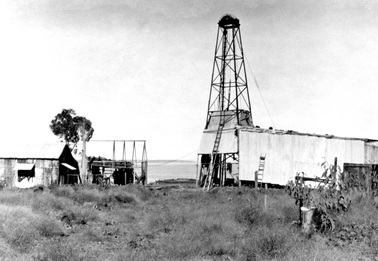
Within 20 years of federation, the Australian Government had posted a £50,000 reward for the discovery of oil in commercial quantity. For this reason, the arrival in Darwin of the Government auxiliary ketch 'John Alce' in the middle of 1922 was a critical event as the ship's engineer, Mr. Phillips, was carrying the bitumen samples recently collected by Rev. Jennison on Elcho Island. Jennison had asked him to deliver them to Darwin Dentist Dr. C.E. Hill. On the 12th August Jennison found more bitumen including some in situ - apparently disproving the theory of Territory bitumen floating down from Borneo.
Upon receipt of the bitumen, Dr. Hill registered the Elcho Island Development Syndicate with F.J. King (Chairman); P. Brennan (sec.) C.E. Hill (Treasurer); E.P. Zakharow (Manager) and on 24th October 1921 lodged an application for a Mineral Oil and Coal Licence over Elcho Island, Wessel (Marchinbar) Island as well as Howard, Banyan & Dere (sic) Islands.
The Syndicate formed a prospecting party under the direction of Russian agriculturalist/geologist Mr. (Dr/Professor) Eugene P. Zakharow, a Russian 'agricultural expert' who had arrived in 1914 as a member of a company proposing to grow rice, cotton & tobacco on the Daly River under Dr. Gilruth's State Farm Scheme. Zakharow claimed to be 'a professional culturist' reputed to hold a diploma in agriculture with experience in growing cotton in Persia, Turkestan, Bokhara & India. In 1915 he was employed by the Administration to cultivate cotton at the Batchelor Demonstration Farm. When the plots failed he was transferred to the Daly River Government Farm. After a 'difference of opinion' with management he took up a selection which he battled unsuccessfully until coming to Darwin in 1923.
Zakharow claimed to have discovered a significant seam of coal at the Daly River that he was about to commercialise when the Elcho Oil venture intervened. After the failure of which he claimed to be averse to becoming a naturalised British subject in order to secure a mining lease. Subsequent private & Government prospecting failed to locate this El Dorado. Following the failure of his cotton & tobacco plantation as the hub of a Russian community, Zakharow re-surfaced in Darwin claiming to be a geologist having experience in the Persian & Russian oil fields - "In Mr. Zakharow's opinion the oil belt which extends from Romania through the Maikop, Grozny and Baku (Russian) fields, Persia, Burma, Sumatra, Borneo and Timor, extends to Elcho Island."
On 26th August 1922, after a 5 day voyage from Darwin, the prospecting party landed at Elcho with a hand boring plant to commence exploration. Jennison showed Zakharow where he had found the bitumen in situ - Zakharow took further samples which on the 25th September arrived in Darwin with Zakharow aboard the John Alce and were displayed at Dr. Hill's residence before eager investors. One sample was 22" (inches) long, 16" wide and 1.5" thick. Some samples were sent for testing to Mr. Norman C. Bell the Government Assayer at the Department of Mines. Tests by Dr Hill showed the presence of gas and free mineral oil "it burns freely and gives off a distinct odour of petroleum."
On the 10th October Zakharow boarded the S.S. Marella in Darwin heading south as the Syndicate's representative empowered "to transact certain business on its behalf". Coincidentally, Mr. J.T. Beckett (Chief Inspector of Aborigines) was also bound for Melbourne to float "an oil proposition in which he is interested."
On the 24th October the Syndicate lodged an application for a Mineral & Coal Licence over Elcho Island.
Later at Melbourne in May 1923 Zakharow claimed to have discovered the bitumen deposit. After receiving a glowing report in 1923 from Zakharow, the syndicate formed the Elcho Island Naphtha Petroleum Company Limited which raised £200,000. The company secretary Colonel Serennikoff was based at the company's head office in Melbourne - Mr S.J.A. Fripp chairman of directors.
When asked if his qualifications were ever doubted Zakharow replied "Yes, but my being here is sufficient to show how unfounded the doubts were. One of the conditions laid down by the company before purchasing from the syndicate was that I would act as the company's engineer and geologist." As yet there are no details to hand of financial transactions involving the company and the syndicate.
The site contains artefacts & three bore holes. Future site development should be proceeded by a site clearance.
Upon receipt of the bitumen, Dr. Hill registered the Elcho Island Development Syndicate with F.J. King (Chairman); P. Brennan (sec.) C.E. Hill (Treasurer); E.P. Zakharow (Manager) and on 24th October 1921 lodged an application for a Mineral Oil and Coal Licence over Elcho Island, Wessel (Marchinbar) Island as well as Howard, Banyan & Dere (sic) Islands.
The Syndicate formed a prospecting party under the direction of Russian agriculturalist/geologist Mr. (Dr/Professor) Eugene P. Zakharow, a Russian 'agricultural expert' who had arrived in 1914 as a member of a company proposing to grow rice, cotton & tobacco on the Daly River under Dr. Gilruth's State Farm Scheme. Zakharow claimed to be 'a professional culturist' reputed to hold a diploma in agriculture with experience in growing cotton in Persia, Turkestan, Bokhara & India. In 1915 he was employed by the Administration to cultivate cotton at the Batchelor Demonstration Farm. When the plots failed he was transferred to the Daly River Government Farm. After a 'difference of opinion' with management he took up a selection which he battled unsuccessfully until coming to Darwin in 1923.
Zakharow claimed to have discovered a significant seam of coal at the Daly River that he was about to commercialise when the Elcho Oil venture intervened. After the failure of which he claimed to be averse to becoming a naturalised British subject in order to secure a mining lease. Subsequent private & Government prospecting failed to locate this El Dorado. Following the failure of his cotton & tobacco plantation as the hub of a Russian community, Zakharow re-surfaced in Darwin claiming to be a geologist having experience in the Persian & Russian oil fields - "In Mr. Zakharow's opinion the oil belt which extends from Romania through the Maikop, Grozny and Baku (Russian) fields, Persia, Burma, Sumatra, Borneo and Timor, extends to Elcho Island."
On 26th August 1922, after a 5 day voyage from Darwin, the prospecting party landed at Elcho with a hand boring plant to commence exploration. Jennison showed Zakharow where he had found the bitumen in situ - Zakharow took further samples which on the 25th September arrived in Darwin with Zakharow aboard the John Alce and were displayed at Dr. Hill's residence before eager investors. One sample was 22" (inches) long, 16" wide and 1.5" thick. Some samples were sent for testing to Mr. Norman C. Bell the Government Assayer at the Department of Mines. Tests by Dr Hill showed the presence of gas and free mineral oil "it burns freely and gives off a distinct odour of petroleum."
On the 10th October Zakharow boarded the S.S. Marella in Darwin heading south as the Syndicate's representative empowered "to transact certain business on its behalf". Coincidentally, Mr. J.T. Beckett (Chief Inspector of Aborigines) was also bound for Melbourne to float "an oil proposition in which he is interested."
On the 24th October the Syndicate lodged an application for a Mineral & Coal Licence over Elcho Island.
Later at Melbourne in May 1923 Zakharow claimed to have discovered the bitumen deposit. After receiving a glowing report in 1923 from Zakharow, the syndicate formed the Elcho Island Naphtha Petroleum Company Limited which raised £200,000. The company secretary Colonel Serennikoff was based at the company's head office in Melbourne - Mr S.J.A. Fripp chairman of directors.
When asked if his qualifications were ever doubted Zakharow replied "Yes, but my being here is sufficient to show how unfounded the doubts were. One of the conditions laid down by the company before purchasing from the syndicate was that I would act as the company's engineer and geologist." As yet there are no details to hand of financial transactions involving the company and the syndicate.
The site contains artefacts & three bore holes. Future site development should be proceeded by a site clearance.
The Huddersfield Expedition
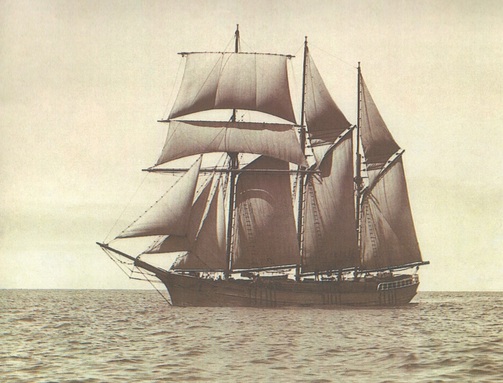 The Snail of the Sea - The Huddersfield in her pomp - Lady Denman Maritime Museum
The Snail of the Sea - The Huddersfield in her pomp - Lady Denman Maritime Museum
The infamous Huddersfield Expedition was a long running fiasco that fomented following the loss of the S.S. Douglas Mawson (333
tons). She was a wooden ketch rigged twin screw Government steamer operating between Cairns & the Gulf of
Carpentaria. On 29 March 1923 she disappeared en route from Burketown to Thursday Island during a cyclone centred near Groote Eylandt. Twenty people aboard
lost their lives & it was to give rise to a prolonged public outcry fanned by the newspapers & proclivities of the day.
A marine board of inquiry was set up to establish the cause of the wreck & concluded the absence of a barometer was a major contributing factor. Wreckage was identified on the Arnhem Land coast some 12 months later. Her loss & location of the wreck remain among northern Australia's abiding maritime mysteries.
It was Zakharow who in August 1924 raised the outrageous claims that two white female survivors were held captive by wild Arnhem Land Aboriginals who had killed the male castaways as they came ashore on the western side of the Gulf of Carpentaria. One of the women had subsequently given birth to a white baby.
A frenzied surge of alarm was raised by the women of Queensland which resulted in the Qld Parliament offering to assist the NT Administration's rescue efforts. Zakharow & crew set out in the Pat to investigate at the request of NT Administrator Mr P. Urquhart. They reportedly learned from, Banaka, an Aboriginal boy in the English Company Islands that a Port Bradshaw man, Keet Parloo, had led a party of Caledon Bay & Port Bradshaw natives in an attack on the survivors of the Douglas Mawson. The women & infant were healthy but well guarded. Zakharow's witnesses were R. Stuart the mate of the Huddersfield; George Tozer the mine's engineer and William Stanley.
A marine board of inquiry was set up to establish the cause of the wreck & concluded the absence of a barometer was a major contributing factor. Wreckage was identified on the Arnhem Land coast some 12 months later. Her loss & location of the wreck remain among northern Australia's abiding maritime mysteries.
It was Zakharow who in August 1924 raised the outrageous claims that two white female survivors were held captive by wild Arnhem Land Aboriginals who had killed the male castaways as they came ashore on the western side of the Gulf of Carpentaria. One of the women had subsequently given birth to a white baby.
A frenzied surge of alarm was raised by the women of Queensland which resulted in the Qld Parliament offering to assist the NT Administration's rescue efforts. Zakharow & crew set out in the Pat to investigate at the request of NT Administrator Mr P. Urquhart. They reportedly learned from, Banaka, an Aboriginal boy in the English Company Islands that a Port Bradshaw man, Keet Parloo, had led a party of Caledon Bay & Port Bradshaw natives in an attack on the survivors of the Douglas Mawson. The women & infant were healthy but well guarded. Zakharow's witnesses were R. Stuart the mate of the Huddersfield; George Tozer the mine's engineer and William Stanley.
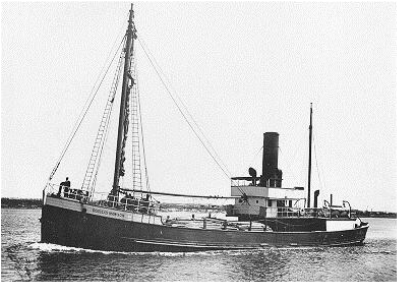 Douglas Mawson
Douglas Mawson
A Police Station was established at Mount Alexander with Constables Bridgeland & McNamara. The Government raised the Huddersfield Relief Expedition in August 1924 under M.C. Lovegrove to search for the missing women. Sergeant Stretton arrived at Elcho after the chartered Huddersfield had sailed and his questioning of the informants cast immediate doubt on previous accounts and subsequent press assertions that on the approach of the Huddersfield the women were taken away in canoes. Further evidence by Rev. James Watson and others further discredited Zakharow's claims which had generated considerable amusement among the Yolngu families. Lovegrove concluded that the story of the white women had originated in the arrival of two mission ladies and a baby at Emerald River on Groote Eylandt.
The original story may have gained traction following the capture of a white woman in Torres Strait after a trepang lugger foundered. She was held as a spirit Queen until eventually she managed to escape and return to civilisation. The stories of white women were able to persist because of a family at Numbulwar & Ngukurr which has albino genetic propensity. Sunburn is such a threat that these sufferers live a life of unnatural seclusion - the arrival of a vessel would result in everyone dropping everything & rushing down to the beach - from the ship would be seen two white women appearing amongst the throng - they would be pursued and dragged away kicking and screaming out of sight. The family continues to battle to protect its white offspring against the scorching sun in a tradition of exceptional care exemplified by the oldest man in Arnhem Land having had leprosy for well over half a century.
The whole embarrassing episode concluded with the Police Station at Mt Alexander closing the following Dry season. In 1926 after the collapse of the Elcho Island company, Zakharow was at Bickerton Island investigating more bitumen deposits. He reported the murder of an Aboriginal called Timbuck and Assari the Japanese master of the lugger Onyx registered to Willie Howe, the Darwin manager of a Chinese fishing syndicate. The lugger was salvaged by W. (Bill) Harney & HM Foster who took it to East Bay Island off Groote Eylandt. Subsequent testimony by Foster reported that Banaka was one of four Balamumu recruited by Assari to help recover some of his crew whom he had forced to go trepanging at Cape Wilberforce against their will and escaped in a dingy in which they were trying to get back to Groote when they landed on Bickerton Island. Banaka was killed in the affray and it transpired that he had been an employee of Zakharow when he turned informant in the Mawson affair.
The Elcho Island Naphtha Petroleum Company was affiliated with the Boucaut Bay Company Ltd. and the Junction Bay Mazut Company Ltd.
Wilbur Chaseling writes in Yulengor on page one that his young imagination was fired by hearing the 'fantastic rumours' that grew out of the disappearance of the Douglas Mawson and appropriation of white women by Stone Age savages 'the tale was accepted and world-wide indignation was aroused'. Chaseling established Yirrkala Mission in 1935 and his houseboy was Narritjin who would survive the loss of HMAS Patricia Cam and become a famous artist. Chaseling also notes the ludicrous proposition that anything can be kept secret in the bush let alone two white women.
The original story may have gained traction following the capture of a white woman in Torres Strait after a trepang lugger foundered. She was held as a spirit Queen until eventually she managed to escape and return to civilisation. The stories of white women were able to persist because of a family at Numbulwar & Ngukurr which has albino genetic propensity. Sunburn is such a threat that these sufferers live a life of unnatural seclusion - the arrival of a vessel would result in everyone dropping everything & rushing down to the beach - from the ship would be seen two white women appearing amongst the throng - they would be pursued and dragged away kicking and screaming out of sight. The family continues to battle to protect its white offspring against the scorching sun in a tradition of exceptional care exemplified by the oldest man in Arnhem Land having had leprosy for well over half a century.
The whole embarrassing episode concluded with the Police Station at Mt Alexander closing the following Dry season. In 1926 after the collapse of the Elcho Island company, Zakharow was at Bickerton Island investigating more bitumen deposits. He reported the murder of an Aboriginal called Timbuck and Assari the Japanese master of the lugger Onyx registered to Willie Howe, the Darwin manager of a Chinese fishing syndicate. The lugger was salvaged by W. (Bill) Harney & HM Foster who took it to East Bay Island off Groote Eylandt. Subsequent testimony by Foster reported that Banaka was one of four Balamumu recruited by Assari to help recover some of his crew whom he had forced to go trepanging at Cape Wilberforce against their will and escaped in a dingy in which they were trying to get back to Groote when they landed on Bickerton Island. Banaka was killed in the affray and it transpired that he had been an employee of Zakharow when he turned informant in the Mawson affair.
The Elcho Island Naphtha Petroleum Company was affiliated with the Boucaut Bay Company Ltd. and the Junction Bay Mazut Company Ltd.
Wilbur Chaseling writes in Yulengor on page one that his young imagination was fired by hearing the 'fantastic rumours' that grew out of the disappearance of the Douglas Mawson and appropriation of white women by Stone Age savages 'the tale was accepted and world-wide indignation was aroused'. Chaseling established Yirrkala Mission in 1935 and his houseboy was Narritjin who would survive the loss of HMAS Patricia Cam and become a famous artist. Chaseling also notes the ludicrous proposition that anything can be kept secret in the bush let alone two white women.
The Japanese Pearl Shell Divers
The commercial pearling industry had started in Darwin with the arrival in 1884 of the schooner "Sree pas Sair (SPS)" which had a crew of 60 skindivers from Thursday Island & once been the yacht of Rajah Brooke. Since 1935 it had been the practice for some vessels attached to local pearling fleets to work off the Aru Islands during the Wet and off Bathurst Island during the Dry. Japanese crew had worked on the trepang luggers out of Darwin for many years but it was not until the arrival of the Japanese fleets with their mother ships that conflict and wholesale exploitation of Aboriginals.
The Japanese Sail Trainer Kaiwo Maru Darwin 1936 - having been issued with cameras, the cadets were shown and allowed to photograph every Darwin shore defence facility that was so comprehensively bombed six years later. It was a ploy which she successfully repeated at half a dozen ports on the voyage. The Japanese pearling fleet remained outside Darwin harbour reporting the disposition of ships and resources until 1942.
Throughout the war servicemen reported that from a high vantage point during a night raid you could see torches flashing signals to the aircraft - calling the bombers in. Regrettably a great deal of anger was directed at the Chinese despite China bearing the brunt of Japanese savagery. There were issues with slums & insanitary practices but wholesale destruction was meted out. It is reported that the Fishermen's Temple at Doctor's Gully was actually bombed in the clearance for the Catalina Base - a project is underway to construct a small memorial to the temple, including a replacement of the Prayer Furnace.
Throughout the war servicemen reported that from a high vantage point during a night raid you could see torches flashing signals to the aircraft - calling the bombers in. Regrettably a great deal of anger was directed at the Chinese despite China bearing the brunt of Japanese savagery. There were issues with slums & insanitary practices but wholesale destruction was meted out. It is reported that the Fishermen's Temple at Doctor's Gully was actually bombed in the clearance for the Catalina Base - a project is underway to construct a small memorial to the temple, including a replacement of the Prayer Furnace.
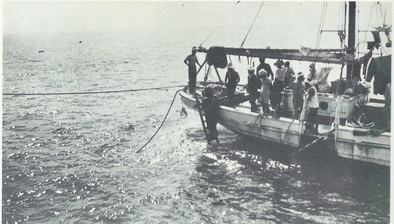 Tokyo Maru No 2 diving on Sanyo Maru 1937.
Tokyo Maru No 2 diving on Sanyo Maru 1937.
The Japanese Pearling fleet incursions into Top End waters began in 1936 - rapidly becoming a threat to the oyster beds & the health of the locals through the spread of venereal disease.
The sinking of the Japanese mother ship Sanyo Maru off the Liverpool River in 1937 began a frenzy of 3 salvage vessels working day & night to recover the cargo & the contents of the captains safe.
The contents of the safe was likewise the major concern in the sinking of HMAS Patricia Cam. It was believed that Japanese pearl divers were capable of reaching the safe with minimal equipment from a float plane or submarine.
The sinking of the Japanese mother ship Sanyo Maru off the Liverpool River in 1937 began a frenzy of 3 salvage vessels working day & night to recover the cargo & the contents of the captains safe.
The contents of the safe was likewise the major concern in the sinking of HMAS Patricia Cam. It was believed that Japanese pearl divers were capable of reaching the safe with minimal equipment from a float plane or submarine.
Constable John (Jack) Stokes
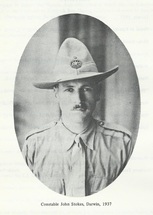
By 1937 the Japanese had over 100 luggers and their presence along the Arnhem Land coast was a major concern with no illusions harboured as to their reconnaissance activities. The pearl shell beds off the Tiwi Islands were exhausted and the fleet moved to new grounds between the Goulburn Islands and the Wessels. Five Darwin based pearling masters, including the notable Captain Gregory, operated a fleet of 25 vessels crewed by Malay and Japanese divers. Efforts to protect Aboriginals form disease and corruption saw an ordinance forbidding vessels from landing for any purposes including watering. The local pearling trade was compromised and the Government resolved to establish supervised watering sites for licensed pearlers. Police Constables Peter Riley (later Peter Brunn) & Jack Stokes were sent out to establish camps to monitor the Japanese activities at the King River opposite South Goulburn Island and at Elcho Island. They were to be supported by the vessel Larrakia and a native tracker.
Stokes' camp on Elcho was just behind the spring on the beach. He erected his tents on the foundations of the old mission. His pedal radio which arrived in early 1938 located was up on Ganapay Cliffs (below the current clinic & graves) also affording the widest view of approaching pearling luggers. There was a small, low stone & concrete building that housed the radio - it has been unsympathetically remodelled by a bulldozer but the remains are still there.
Stokes rapidly developed a good relationship with the locals and his boat with an in-board motor would have been very impressive. He was unable to do anything for the leprosy sufferers but yaws responded well to injections of the arsenic based Salvarsan which was the first effective syphilis treatment prior to Penicillin in 1943 - 'heal the sick - it opens many doors'. The treatment regimen called for 3 injections over several days - with exactly the same result as today - a vanishing act. Dubbed the "Monarch" of Elcho Island, Stokes' visitors included Alec Ladd in Katinka delivering fuel & supplies and Haultain & Cassidy in the patrol boat Larrakia. Stokes grew vegetables and build a goat pen, storeroom, kitchen and tracker's quarters. He and a crew of helpers cleared two airstrips and approaches on the island. One was taken over by Bapa Sheppy along what is now the barge-landing road.
In 1938 it was reported that the Japanese had taken 4,500 tons of shell off the Arnhemland coast in the previous year. Although luggers were often sighted, only two dropped anchor to use the watering facilities at Elcho. One was from Thursday Island and the other a Japanese vessel. King River was heavily used but there was ample water at the top of Elcho and in the Wessel Islands. There were some 2000 Japanese pearlers on the coast and each of the mother ships had radios. With the pearl shell exhausted, the fleet move to new grounds some forty miles west of Bathurst Island.
On 13th September a telegram advised that the stations at King River & Elcho were to be closed. Ten days later Donald Thomson's old yacht Saint Nicholas arrived, she was now the Milingimbi mission boat under command of Samoan lay-missionary Kolinio. It was with great regret that Stokes was obliged to leave Elcho & it was generally seen as further appeasement of the Japanese who continued to monitor the coastal shipping until the bombing of Darwin.
Stokes' camp on Elcho was just behind the spring on the beach. He erected his tents on the foundations of the old mission. His pedal radio which arrived in early 1938 located was up on Ganapay Cliffs (below the current clinic & graves) also affording the widest view of approaching pearling luggers. There was a small, low stone & concrete building that housed the radio - it has been unsympathetically remodelled by a bulldozer but the remains are still there.
Stokes rapidly developed a good relationship with the locals and his boat with an in-board motor would have been very impressive. He was unable to do anything for the leprosy sufferers but yaws responded well to injections of the arsenic based Salvarsan which was the first effective syphilis treatment prior to Penicillin in 1943 - 'heal the sick - it opens many doors'. The treatment regimen called for 3 injections over several days - with exactly the same result as today - a vanishing act. Dubbed the "Monarch" of Elcho Island, Stokes' visitors included Alec Ladd in Katinka delivering fuel & supplies and Haultain & Cassidy in the patrol boat Larrakia. Stokes grew vegetables and build a goat pen, storeroom, kitchen and tracker's quarters. He and a crew of helpers cleared two airstrips and approaches on the island. One was taken over by Bapa Sheppy along what is now the barge-landing road.
In 1938 it was reported that the Japanese had taken 4,500 tons of shell off the Arnhemland coast in the previous year. Although luggers were often sighted, only two dropped anchor to use the watering facilities at Elcho. One was from Thursday Island and the other a Japanese vessel. King River was heavily used but there was ample water at the top of Elcho and in the Wessel Islands. There were some 2000 Japanese pearlers on the coast and each of the mother ships had radios. With the pearl shell exhausted, the fleet move to new grounds some forty miles west of Bathurst Island.
On 13th September a telegram advised that the stations at King River & Elcho were to be closed. Ten days later Donald Thomson's old yacht Saint Nicholas arrived, she was now the Milingimbi mission boat under command of Samoan lay-missionary Kolinio. It was with great regret that Stokes was obliged to leave Elcho & it was generally seen as further appeasement of the Japanese who continued to monitor the coastal shipping until the bombing of Darwin.
Jack Stokes returned to the Darwin force until in 1940 he married and was almost immediately posted to Maranboy south of Katherine to replace Constable Vic Hall, who recounted his involvement in the events that led to the killing of Constable McColl in the somewhat fanciful "Dreamtime Justice". Subsequently, Stokes was appointed Official Representative in 1958 at the Cocos (Keeling) Islands and in 1960 Christmas Island. In 1966 he joined the Department of Territories in Canberra.
The Second Mission 1942
Escape from Milingimbi RAAF forward base - Woolen River evacuation camp.
33 Days - WWII Survival
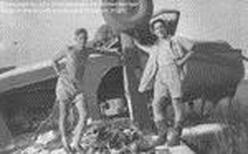 Tugan LJW-7A Gannet VH-UVY, A14-6
Tugan LJW-7A Gannet VH-UVY, A14-6
Overturned during forced landing Cato River, Arnhem
Land NT. 19.5.1942 - Pilot Flt Sgt Frank Smallhorn, W/T Operator AC1
George Booth & nursing orderly Phil Bronk left Batchelor for Groote
Eylandt to collect an ill airman. They became lost over Arnhem Land &
attempted a forced landing on a floodplain near the mouth of the Gurumurru
River, the aircraft turned on to its
back. They were not injured but their location was unknown - so began a saga of survival detailed in George Booth's 1988 book 33 Days (Greenhouse).
After 10 days they set off on a raft built from two fuel tanks, drifted to Elcho Island where they met Nyambi & Mattjuwi, who took them to the mission & thence to Millingimbi.
After 10 days they set off on a raft built from two fuel tanks, drifted to Elcho Island where they met Nyambi & Mattjuwi, who took them to the mission & thence to Millingimbi.
| sheppy_letter_re-gannet_33_days.pdf | |
| File Size: | 1551 kb |
| File Type: | |
The Loss of HMAS Patricia Cam
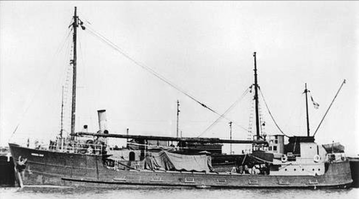
In January 1943, shortly after leaving Elcho Island en route for Jensen Bay - HMAS Patricia Cam was bombed by a Japanese floatplane which landed & took Rev. Len Kentish to Aru Islands where he was beheaded. The offender was hanged at Hong Kong Gaol after the war.
Two crew & two Yolngu died in the attack - two crew floated away in the night - fourteen crew & three Yolngu made it to a small island where stoker Percy Cameron & Gitjbapuy Marrkulu died and were buried side by side where they remain to this day.
Paddy Babawun a 'native pilot' and Narritjin a renowned artist coupled with the skill of Coastwatcher 'Jack' Jensen & pilot Len Gairns - saved the lives of 14 crewmen who returned to Darwin aboard HMAS Kuru - which has her own extraordinary story of wartime survival.
Two crew & two Yolngu died in the attack - two crew floated away in the night - fourteen crew & three Yolngu made it to a small island where stoker Percy Cameron & Gitjbapuy Marrkulu died and were buried side by side where they remain to this day.
Paddy Babawun a 'native pilot' and Narritjin a renowned artist coupled with the skill of Coastwatcher 'Jack' Jensen & pilot Len Gairns - saved the lives of 14 crewmen who returned to Darwin aboard HMAS Kuru - which has her own extraordinary story of wartime survival.
The Post-war Mission 1945
Timber Milling
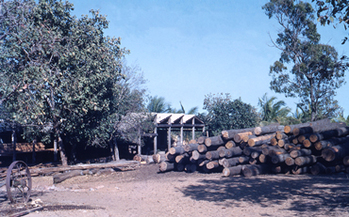 Elcho Island sawmill
Elcho Island sawmill
The timber mill from Milingimbi was relocated to Elcho Island in 1942 and became the most significant operation in East Arnhem Land - providing the timber for houses at Yirrkala, Lake Evella & Millingimbi.
Rev. Bapa Shepherdson came from a famous timber family and he led the way in milling White Ant resistant Cypress Pine. There were teams cutting trees around the homeland centres - other gangs carting & floating logs - plantations being established - mills producing beams, planks & shingles - luggers carrying timber - teams of house builders - painters & gardeners. A time when Yolngu did everything with help from just a handful of balanda.
The last flowering of the trade was supplying vast amounts of timber to Darwin after Cyclone Tracy in 1974. As with all enterprises, the milling did not survive the end of the Mission days and the tide of Government regulation. Final destruction of this building in 2008 was an insult & impetus to preserve what survives to prove what once was achieved.
Rev. Bapa Shepherdson came from a famous timber family and he led the way in milling White Ant resistant Cypress Pine. There were teams cutting trees around the homeland centres - other gangs carting & floating logs - plantations being established - mills producing beams, planks & shingles - luggers carrying timber - teams of house builders - painters & gardeners. A time when Yolngu did everything with help from just a handful of balanda.
The last flowering of the trade was supplying vast amounts of timber to Darwin after Cyclone Tracy in 1974. As with all enterprises, the milling did not survive the end of the Mission days and the tide of Government regulation. Final destruction of this building in 2008 was an insult & impetus to preserve what survives to prove what once was achieved.
The Sea Fox
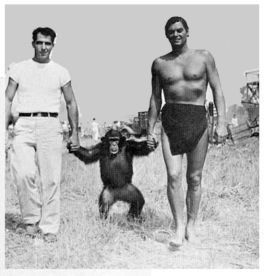 Cheetah with Tarzan Johnny Wiessmuller
Cheetah with Tarzan Johnny Wiessmuller
In 1959 en-route from South East Asia to Sydney and after a refuelling stopover in Darwin, distress calls were heard from the 120ft luxury yacht Sea Fox. This followed a controversial air and sea search, but the yacht was beached at Mission Bay on Elcho Island - predictably at low tide she fell breaking several ribs.
On board its exotic crew included owner and world famous magician & actor, John Calvert, his girlfriend a young Filipino singer, Pilita Corrales, a bevy of beautiful assistants and Jimmy the chimpanzee, better known as Cheetah of the Tarzan movies. It was rumoured that Jimmy escaped the stranded vessel to terrorise the residents of Elcho Island who had never seen a chimpanzee before - let alone one that smoked cigarettes.
John Calvert led a flamboyant lifestyle and was as well-known for his magic as his impecunity & philandering. The Darwin media had a field day reporting many conflicting stories surrounding the sequence of the events and the damage suffered by the yacht, which was lapped up by the international media.
The owner of Doctors Gully, Carl Atkinson, sailed the badly damaged Sea Fox back to Darwin where she was blown on shore from her moorings at Doctors Gully and deemed beyond repair.
A bitter salvage battle followed over ownership rights, which ended when Atkinson sold the once luxurious yacht. The new owner promptly burnt it… all they wanted was the lead ballast from her keel. {See below Peter Simon - Jim Bowditch}
Interviewed in later years Calvert was asked about taking his show on tour - "Well I first carried my show in a car, in the back of the car. Then I got a trailer put behind the car. And then I thought that if I had a truck, I could have a bigger show. And finally I have a huge semi-trailer truck. And then it came to me that 'If I had an airplane' and I thought maybe in ten years…well it wasn't that long at all that I had an airplane, then a DC-3, a Douglas airline, and well I had about a dozen airplanes in my time. And then Henry Ford built a big yacht for his son Edsel. Edsel died, and I bought this hundred foot sailing vessel. And sailed it to Hawaii with the show on board. From Hawwii and up to Japan and down to Singapore, the Philippines, and Australia. Since that I have had a number of motor yachts. Motor sailors, and now I have a pure triple screw world cruising yacht with a cruising range of three thousand miles. And I've travelled all over the world. We crossed the Atlantic in eleven days with it. I would like to point out that this came from magic."
John Calvert 05/07/1911 - 27/09/2013
Pilita Corrales 22/07/1939 - 'Asia's Queen of Song'
On board its exotic crew included owner and world famous magician & actor, John Calvert, his girlfriend a young Filipino singer, Pilita Corrales, a bevy of beautiful assistants and Jimmy the chimpanzee, better known as Cheetah of the Tarzan movies. It was rumoured that Jimmy escaped the stranded vessel to terrorise the residents of Elcho Island who had never seen a chimpanzee before - let alone one that smoked cigarettes.
John Calvert led a flamboyant lifestyle and was as well-known for his magic as his impecunity & philandering. The Darwin media had a field day reporting many conflicting stories surrounding the sequence of the events and the damage suffered by the yacht, which was lapped up by the international media.
The owner of Doctors Gully, Carl Atkinson, sailed the badly damaged Sea Fox back to Darwin where she was blown on shore from her moorings at Doctors Gully and deemed beyond repair.
A bitter salvage battle followed over ownership rights, which ended when Atkinson sold the once luxurious yacht. The new owner promptly burnt it… all they wanted was the lead ballast from her keel. {See below Peter Simon - Jim Bowditch}
Interviewed in later years Calvert was asked about taking his show on tour - "Well I first carried my show in a car, in the back of the car. Then I got a trailer put behind the car. And then I thought that if I had a truck, I could have a bigger show. And finally I have a huge semi-trailer truck. And then it came to me that 'If I had an airplane' and I thought maybe in ten years…well it wasn't that long at all that I had an airplane, then a DC-3, a Douglas airline, and well I had about a dozen airplanes in my time. And then Henry Ford built a big yacht for his son Edsel. Edsel died, and I bought this hundred foot sailing vessel. And sailed it to Hawaii with the show on board. From Hawwii and up to Japan and down to Singapore, the Philippines, and Australia. Since that I have had a number of motor yachts. Motor sailors, and now I have a pure triple screw world cruising yacht with a cruising range of three thousand miles. And I've travelled all over the world. We crossed the Atlantic in eleven days with it. I would like to point out that this came from magic."
John Calvert 05/07/1911 - 27/09/2013
Pilita Corrales 22/07/1939 - 'Asia's Queen of Song'
| |||||||
Boats - Boat Building & Wharves
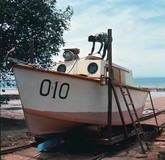 The Gurrum Gurrum
The Gurrum Gurrum
The mission boats were their lifeline and a succession of vessels from the McBride onwards through Larrpan I & II to the Aroetta these tiny boats carried everything from tin tacks to tractors from Darwin to Yirrkala & down to Groote. The 'native pilot' became a feature of the coast from Macassan days & they excelled throughout the War.
Some vessels like the Huddersfield & Sea Fox featured in bazaar episodes worthy even of cave painting as in the case of the monkey. The barge service put an end to the lugger days.
Some vessels like the Huddersfield & Sea Fox featured in bazaar episodes worthy even of cave painting as in the case of the monkey. The barge service put an end to the lugger days.
Aviation Pioneers
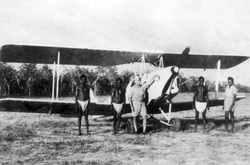 Sheppy & Moth part owned by Harold Guy
Sheppy & Moth part owned by Harold Guy
The first aeroplane built in the NT was at Milingimbi in 1933 when Bapa Sheppy's Heath Parasol took to the air - wing spars and other items survive.
Sheppy's next plane was a Miles Hawk from which he saw Lake Evella naming it for Webb's wife Evellyn & his wife Ella. The Hawk crashed on Groote Eylandt - succeeded by a Tiger Moth in 1947 (did he dropped this one on Howard Island) and a 185 Cessna.
Sheppy's next plane was a Miles Hawk from which he saw Lake Evella naming it for Webb's wife Evellyn & his wife Ella. The Hawk crashed on Groote Eylandt - succeeded by a Tiger Moth in 1947 (did he dropped this one on Howard Island) and a 185 Cessna.
Luggers & Barges
Homelands & Lake Evella
Housing
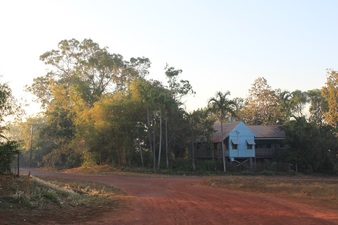
Electrification
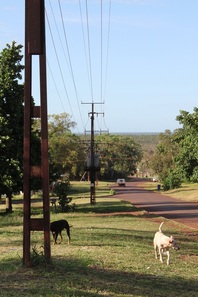
Education - Shepherdson College

Health - Ngalkanbuy Health Centre
Marthakal Homelands Resource Centre
TO BE CONTINUED...................
Sources & Resources
BooksHalf A Century in Arnhem Land
Ella Shepherdson The Whale and the Cross
Conversations with David Burramurra M.B.E. Ian McIntosh The Long Arm
A biography of a NT Policeman - Jack Stokes By Hugh V. Clarke Roebuck Society 1974 Watch Off Arnhem Land
CTG Haultain Master of HMAS Larrakia Roebuck Society 1971 33 DAYS
George Booth Gannet survivors story Greenhouse 1988 Healers of Arnhem Land
Hawaii Press 1972 John Cawte The Universe of the Warramirri Kyodo Press 1993 John Cawte Cruel Poor & Brutal Nations
John Cawte Hawaii Press 1972 Trying to be Sailors
John Leggoe 1983 - re loss of HMAS Patricia Cam Shipbuilders of Brisbane Water NSW
Gwen Dundon 1997 - building of HMAS Pat Cam A Black Civilization
Harper & Row 1937 W. Lloyd Warner Wildey's Australasia and the Oceanic Region
William Wildley George Robertson 1876 A Voyage to Terra Australis
Matthew Flinders 1814 Two visits in 1803 - Investigator & Cumberland Yan-nhangu Atlas and Illustrated Dictionary of the Crocodile Islands
Laurie Baymarrwanga and Dr Bentley James ISBN 10:0975171917 ISBN 13:978-0-9751719-1-2
Macassan History and Heritage
Journeys, Encounters and Influences Edited by Marshall Clark and Sally K. May |
BooksOnly a Wife
Arnhem Land 1945-52 Elizabeth Guy 1991 With Methodist Overseas Missions in North Australia
Elcho Island 1996 Harold Guy The Voyage to Marege'
The definitive Macassan work. C. Campbell. Macknight Melbourne University Press 1976 An Untamed Territory
Elsie Mason Macmillan & Co 1915 Some Historical Ties Between Australia and the Spanish World
Spanish Cultural Society 1988 North of the Never Never
Patrick H. Ritchie Angus & Robertson 1934 Opium smoking etc Thirty Years in Tropical Australia
Rev. Gilbert White 1918 Society for Promoting Christian Knowledge - pearling etc. A Social History of the NT - No. 8 The Mission Stations
Edited by Peter Read NT Dept. Education 1988 In Australian Tropics
Alfred Searcy George Robertson 1909 By Flood & Field Alfred Searcy George Robertson 1911 Health Services in the NT - a History - 1824 -1970
Ellen Kettle ANU - NARU 1991 The Go-Betweens
Jeremy Long NARU 1992 Patrol Officer in the NT Economic Structure and the Ceremonial Exchange Cycle in Arnhem Land
Donald F. Thomson MacMillan Melbourne 1949 Macassan Site Survey and Bibliography
Richard Baker Fieldwork 1982/83 Report on a Survey of Heritage Sites on Former Methodist Missions in Arnhem Land, NT
Peter Forrest 1990 |
Vessels |
Articles Papers
NT Geological Survey 1997 Arnhem Bay-Gove SD53-3,4
Glyde to Yirrkala including Galiwin'ku. David J Rawlings Professor Mulvaney's site has images & commentary on his field work in the 1960s & 1970's.
Professor Ian McIntosh has written extensively upon the anthropology of Elcho Island - Macassans, contact sites & metal working.
| ||||||||||||||||||||||||||||||||||||||||||||||||||||||||||||||||||||||||||||||||||||||||||||||||||||||

